“Once an important center of global diplomacy and commerce, Ayutthaya is now an archaeological ruin, characterized by the remains of tall prang (reliquary towers) and Buddhist monasteries of monumental proportions, which give an idea of the city’s past size and the splendor of its architecture….Indeed, when the capital of the restored kingdom was moved downstream and a new city built at Bangkok, there was a conscious attempt to recreate the urban template and architectural form of Ayutthaya….This pattern of urban replication is in keeping with the urban planning concept in which cities of the world consciously try to emulate the perfection of the mythical city of Ayodhaya. In Thai, the official name for the new capital at Bangkok retains “Ayutthaya” as part of its formal title.”
Introduction
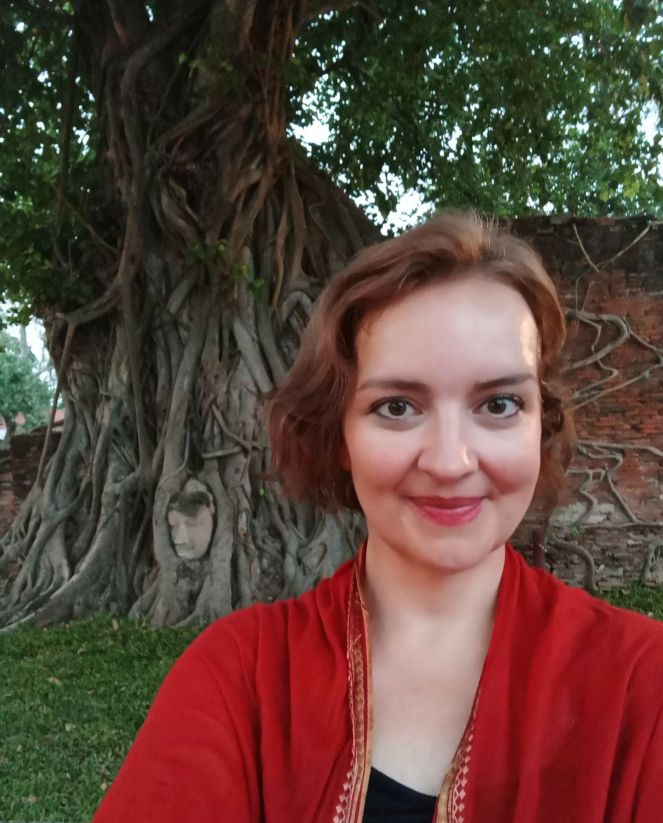
On my return to Thailand after the month in Sri Lanka, I decided to visit another UNESCO world heritage site of the historic and ancient city of Ayutthaya (also spelled “Ayudhya”). Ayutthaya was the former capital of the Ayutthaya kingdom. Located on an island at the confluence of the Chao Phraya and Pa Sak rivers, Ayutthaya is the birthplace of the founder of Bangkok, King Rama I. The ruins of the old city are preserved in the Ayutthaya Historical Park. Founded c. 1350, Ayutthaya became the second Siamese capital after Sukhothai. It was destroyed by the Burmese in the 18th century. Its remains, characterized by the prang (reliquary towers) and gigantic monasteries, give an idea of its past splendour. In this article, I explore the historical background and artistic influences, and how the new capital of Bangkok was heavily influenced by its style, followed by photos of my visit there [1].
In brief, Ayutthaya was one of the most stunning ‘ruins’ I have ever visited (and I have visited many in India and other countries). From Bangkok, I took a regular train from Bangkok Train Station, which took about an hour and a half to arrive at Ayutthaya station (at a very affordable price of 60 Thai Baht/2 USD). The ancient city complex is about a 15 minute drive from there by rickshaw and I shared one with a fellow backpacker I had met briefly while on the train. On arriving at my pre-booked hotel, I immediately took up their suggestion of a two hour boat trip around the moat to see three main Temples (250 Baht/ 8 USD) and a pick up from the hotel itself. The first temple (Wat) housed one of the largest golden Buddhas in the Thailand, the second Temple an exquisitely preserved white tower (Prang) .
In particular, the third ‘Angkor Wat’ of Thailand, Wat Chai Watthanaram, interestingly, for me as a Kālacakra scholar-translator who has studied the Mount Meru Kālacakra mandala in some detail from the practice perspective, is said to reflect the Buddhist world view, as it’s described already in the Traiphum cosmography, with Mount Meru at its centre (for more on that see below). I arrived at that Wat just before and as the sun was setting, where one could witness the change in colours, like an autumn tree from red-brick, browns and greens, to dark brown and golden exquisite silhouettes against the changing colour of light-blue sky to darker navy blue was like poetry in motion and showed the stunning shapes of the architecture and buildings. If it was like the Kālacakra mandala of the universe, it was the perfect setting and time for it!
After that, being able to visit the Wat Mahathat area, with its famous ‘Buddha head in the old Bodhi tree’ was the highlight (or lowlight, as I arrived as the sun was still setting) and very moving indeed. As a teenager onwards, I used to have a photo of this iconic image on my wall and was always struck by its mystery and beauty, even before I ‘became a Buddhist’. However, as we all know, the photo is no substitute for being there in person.
As I write about in this piece here, the energy and sheer scale and beauty of the place, the exhaustions of solo travel and the hot weather led to me being in a fragile emotional (yet open) state when I arrived at the tree during sunset, it literally brought me to my knees and as I knelt before it tears spontaneously poured from eyes, in awe, love and gratitude to witness its sublime beauty. It was like the head itself was vibrantly alive, as if the energy of prayers and pilgrims had enlivened it over the years. I also felt I had visited the place and even seen the statue before. I stopped there for some time to make aspirations and prayers in front of it and I was almost the only person there. No one else was around there anymore, as it turned dark. The stone head could still be seen in the dark lit up by the golden lights within the temple complex. I could have spent hours there meditating on it and absorbing the energy of the place.
There were no security guards around the Buddha head tree. which also surprised me, considering the intense security presence at Buddhist temples in Kandy and in Bangkok. It reminded me of the ancient Nalanda ruins in India and how people had wantonly and disrespectfully graffitied names and other things on the ancient monastic cell rooms and walls. Here, there was no graffiti and no vandalism though. In fact, there were not many people there at all. I took some photos to as memories to share with others and left changed by it with a deep, imprinted memory of it.
Like one of great wonders of the Buddhist world, the historic ruins of Ayutthaya, with its headless Buddha statues, and a Buddha’s head in the beautiful tangled strong roots of a very old tree, was an excellent reminder that even among ruins, beauty and Dharma can still thrive and flourish and ‘live on’ and that the Buddha’s image and teachings are something most precious to preserve.
Sharing the beauty and blessings!
Written by Adele Tomlin, 9th April 2024.
Thailand’s largest ancient Buddha image (Luang Po Tu) at Wat Panan Choeng
The first boat trip stop was at Wat Panan Choeng, on walking through the main temple door, one is greeted by a huge and amazing golden Buddhar statue (see photos). Surrounded by exquisite Buddha statues, it is said to be the largest ancient Buddha image in Thailand. Phra Phanan Choeng was built in 1324, 26 years before King U-Thong founded Ayutthaya. Originally, it is said the Buddha image stood in the open. There is no record about its construction, although there is a legend written down in the
Phongsawadan Nua or Northern Chronicles:
At some time before the Ayutthaya period, there was a Thai King named Phra Chao Sai Namphung requesting the emperor of China’s daughter to be his wife. She travelled from China to this area by boat. When she arrived, the King was not there to greet her. She was heart-broken. She waited for a long time but the King did not come. Finally, she killed herself by holding her breath. The King was very sad, so he had this temple built at her cremation site in order to gain merit for her soul, and he named the temple “Wat Phanan Choeng”.
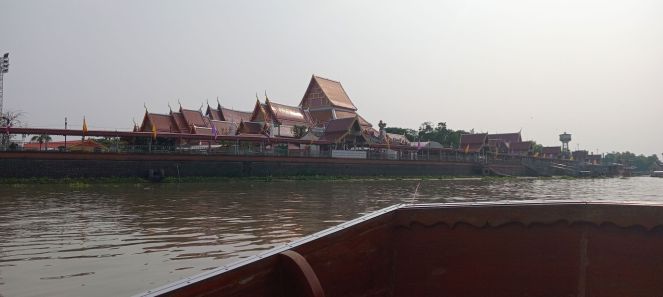

The huge Buddha image – made of brick and mortar and covered with stucco – sits in the classic posture of Subduing Mara. It measures (approx) 14 meters at the lap and 19 meters in height including the ornament above the head. Thai people call it Luang Pho To or Great Reverend Father, Chinese or Thais of Chinese origin call it Sam Po Kong. It is one of the largest, oldest, beautiful and revered Buddha images of Thailand.
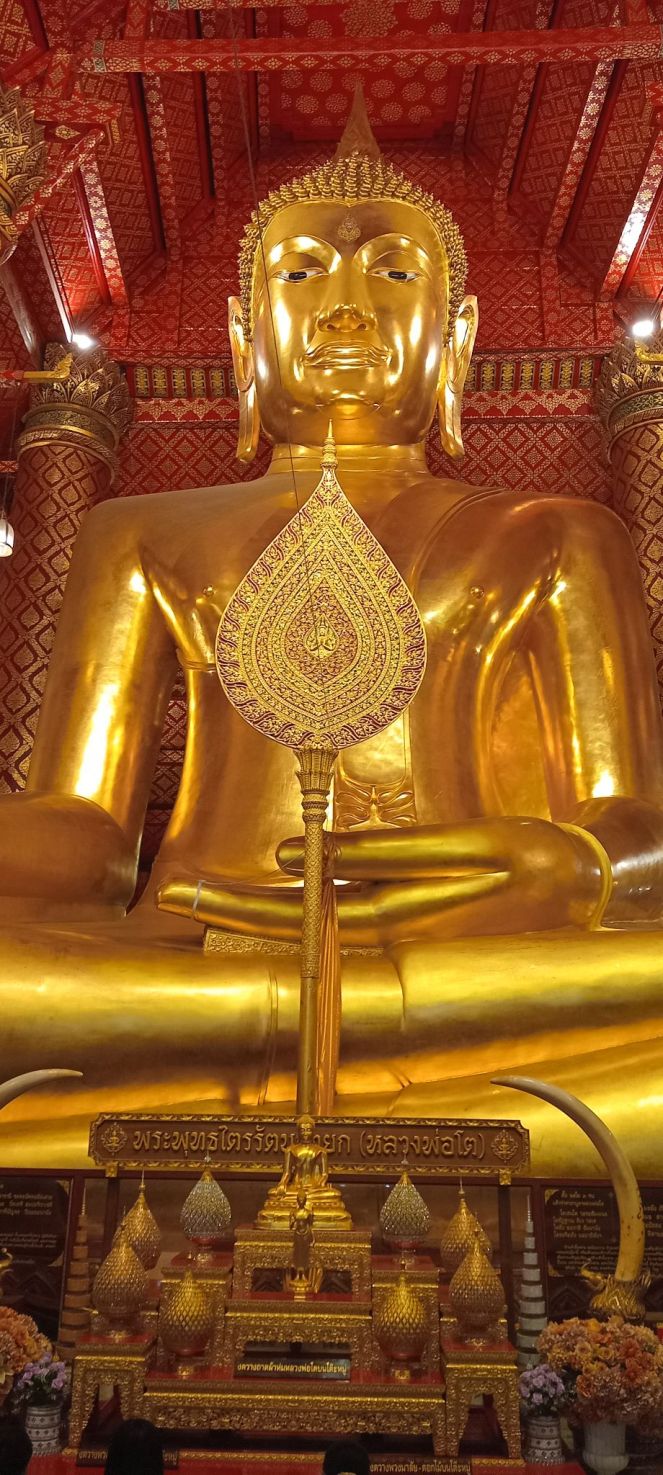
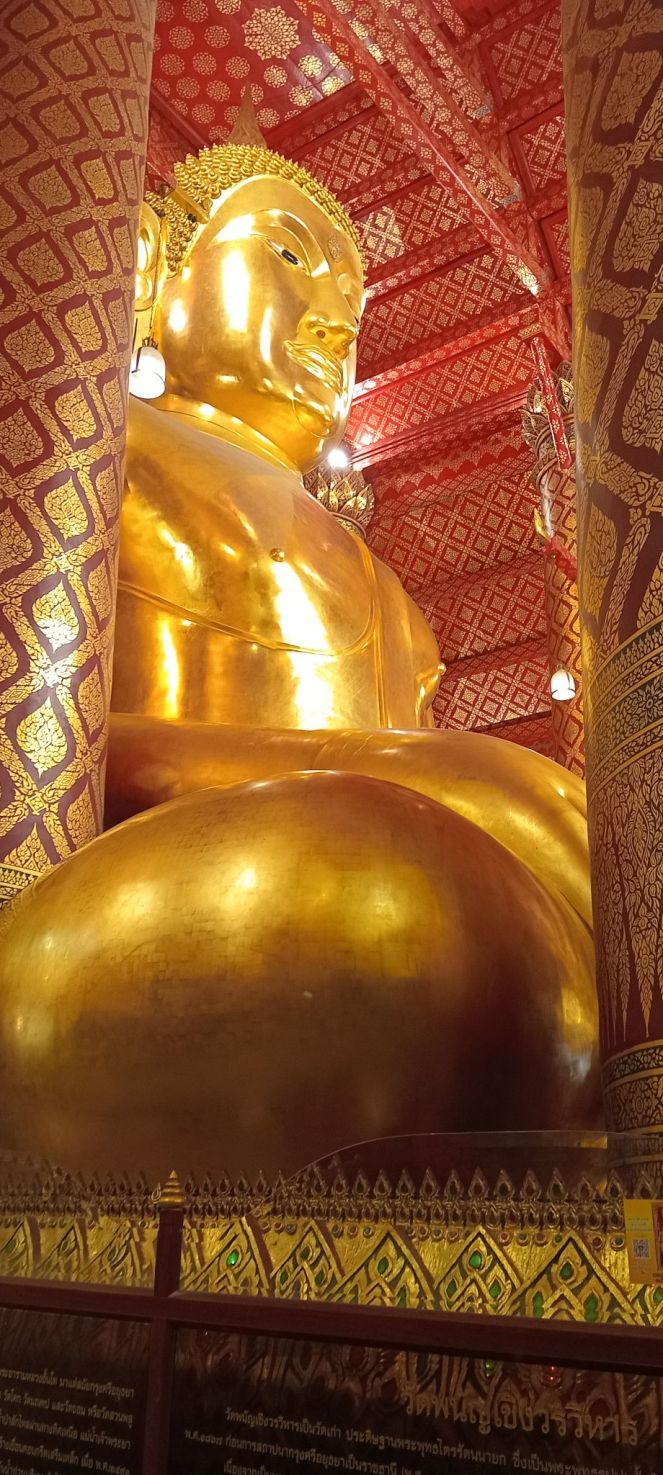
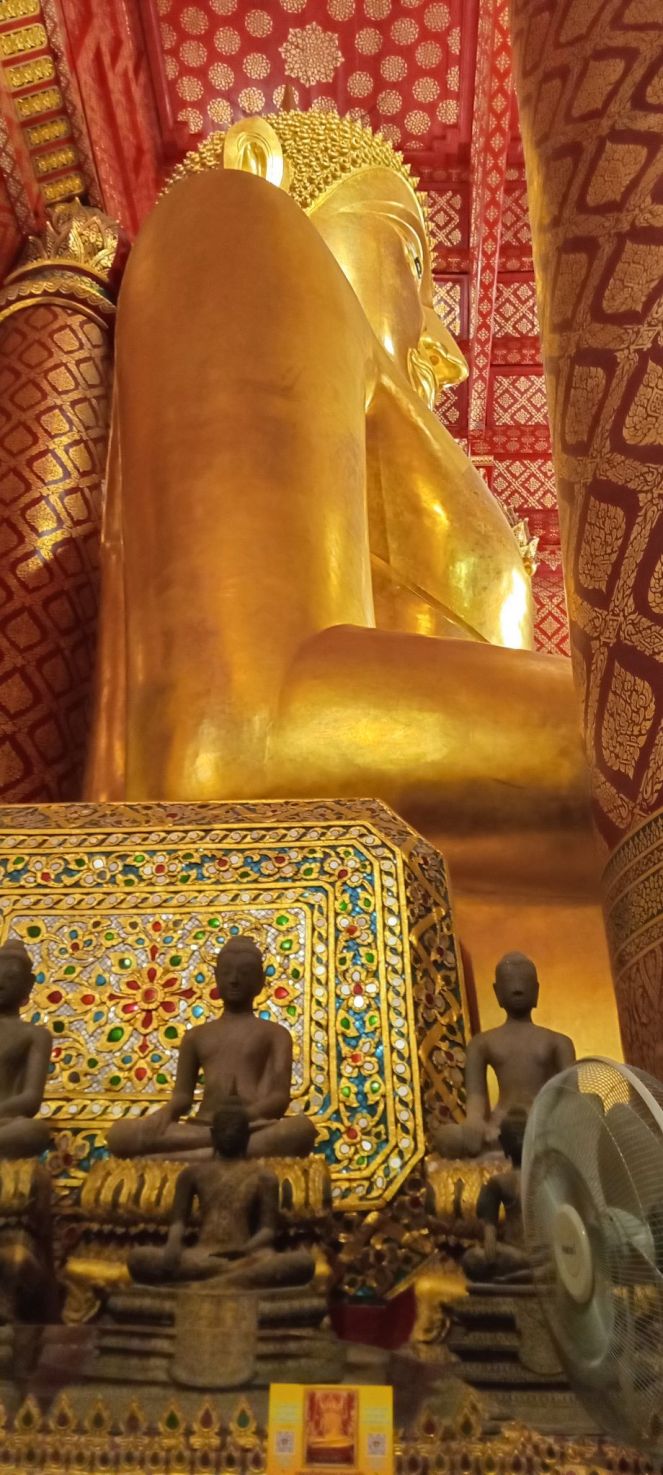
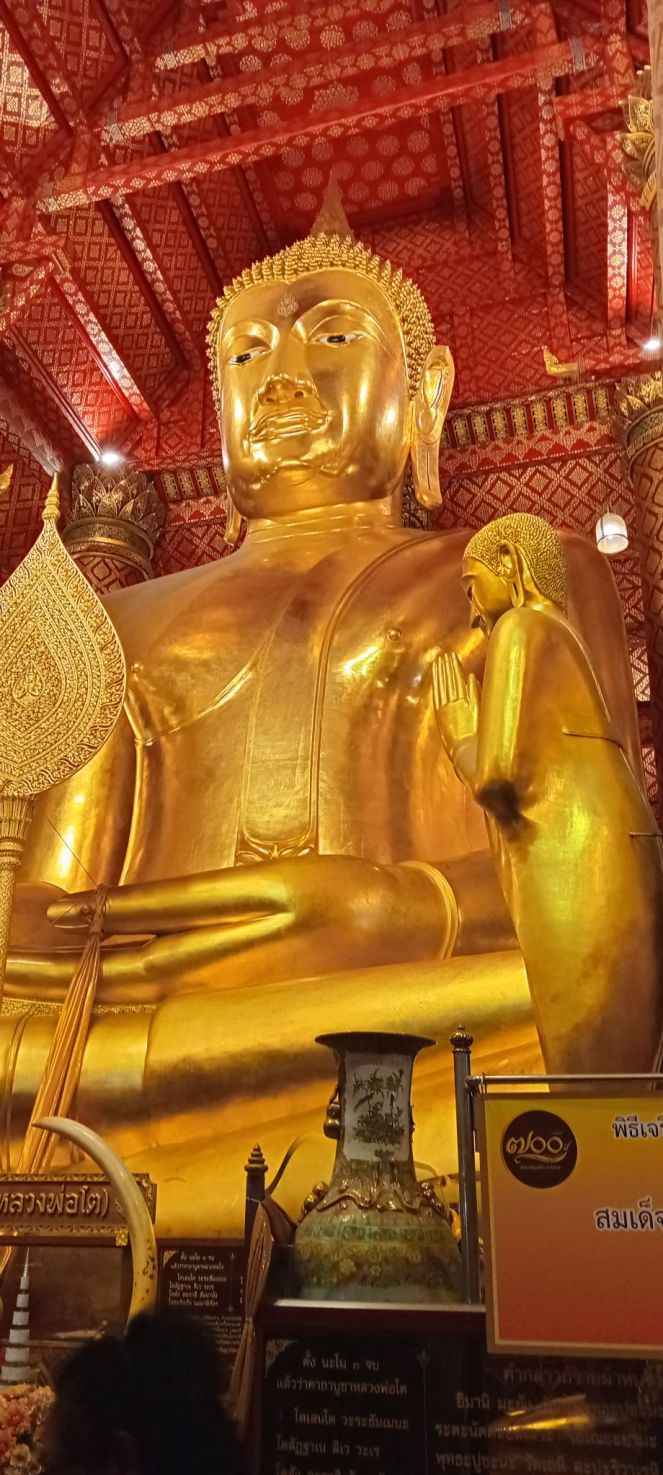
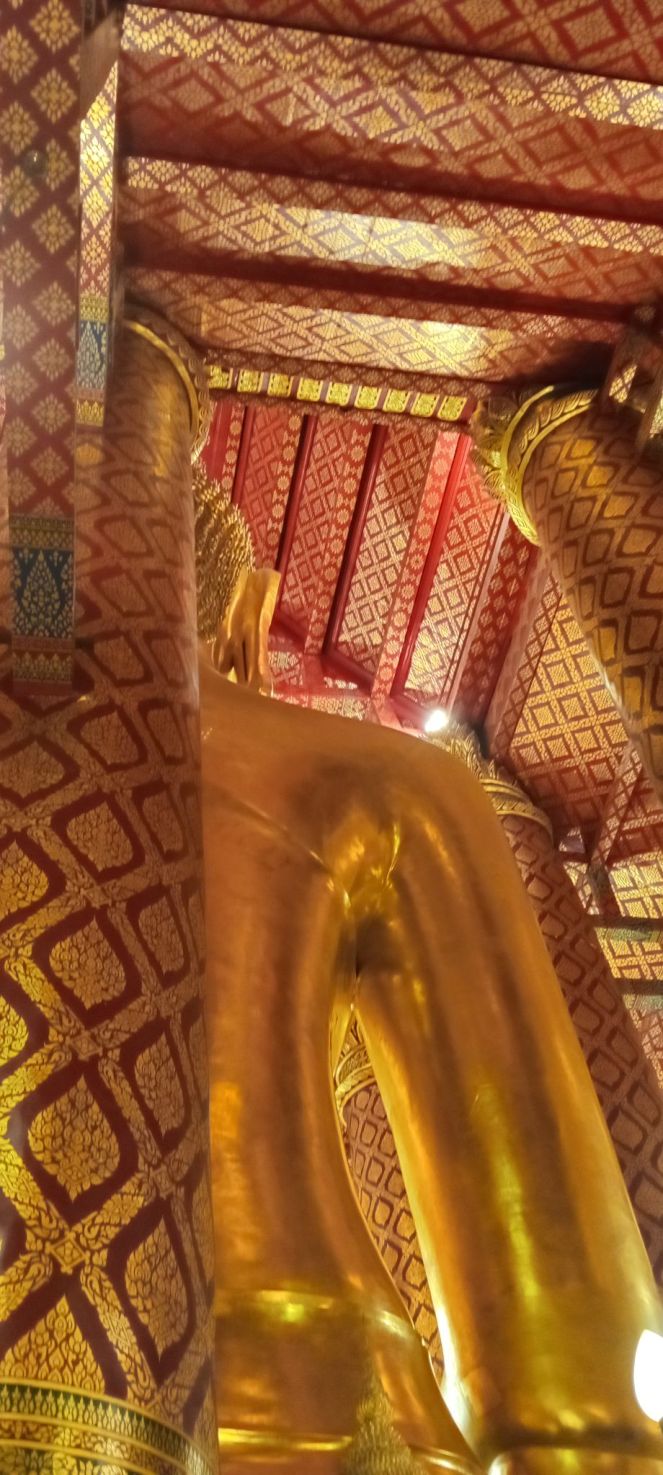

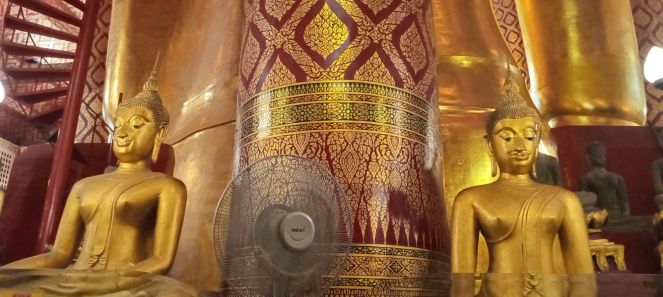

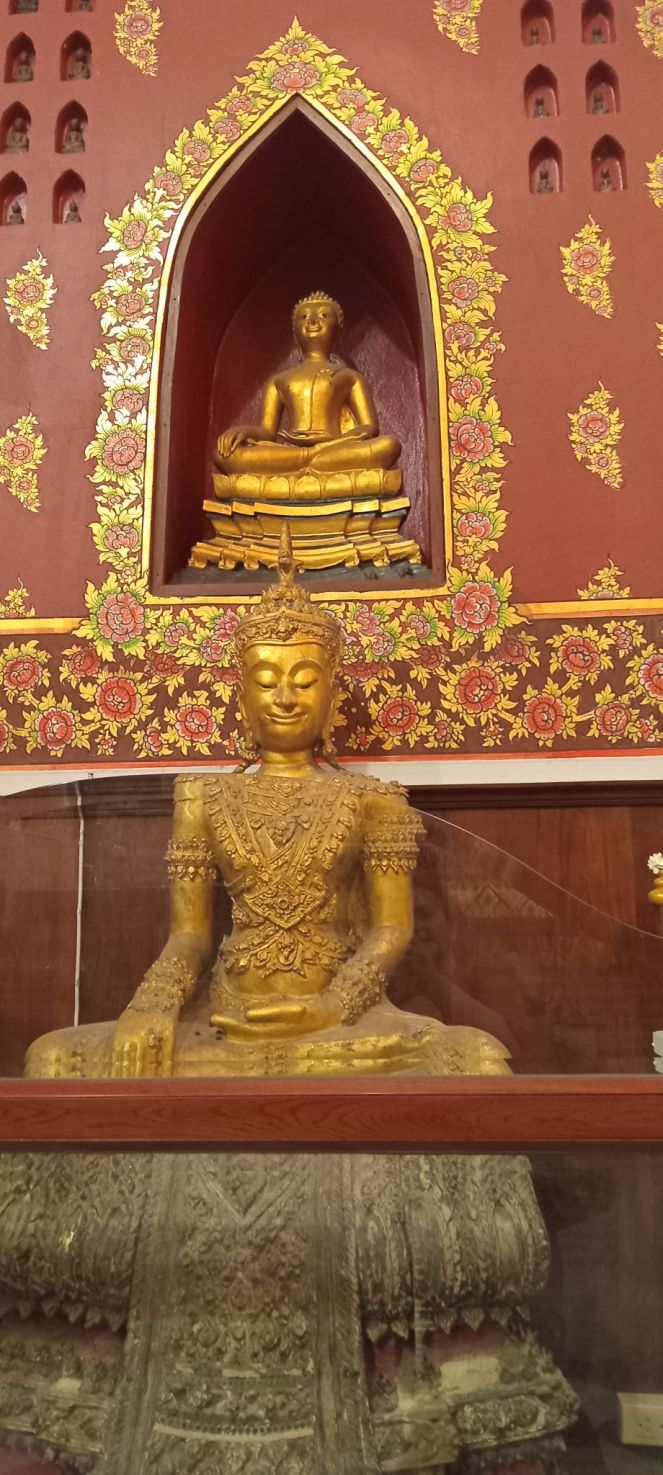
The white Prang tower at Wat Phutthai Sawan
The next Wat to be visited on the boat trip around the moat, was the white prang tower of Wat Phutthai Sawan, which survived the Burmese destruction. According to one website:
“In the Ayutthaya Era, Wat Phutthaisawan was an immence, renowned and most important royal monastery during the reign of Somdet Phra Ramathibodhi I (King U-thong), the first king of the Ayutthaya kingdom. According to the legend, the king commanded the construction of the temple in the royal pavilion compound where he used to stay before the founding of Ayutthaya. The area was referred to in the Royal Chronicles as “Wiang Lek” or “Wiang Hlek” from inconsistent writing. This subdistrict was the first location where the king and his subjects had settled down in 1350 before Ayutthaya was established as the capital city. Unfortunately in 1353 there was a plague, so the king decided to evacuate and set up a new royal palace near Nong Sano (Bueng Phra Ram) where Wat Phra Sri Sanphet is currently located. On the other hand, Wiang Lek became Wat Phutthaisawan to commemorate the founding of the first capital city. In 1353 when Ayutthaya was declared a new capital city, King U-thong ordered the construction of Wat Phutthaisawan in remembrance of the subdistrict where he used to settle down. Later on this developed into a royal tradition in which following kings commanded the building of permanent structures. Wat Phutthaisawan was one of the temples survived the Burmese destruction during the collapse of Ayutthaya in 1767, so the temple remains in its decent condition.Here are some photos I took there below.”


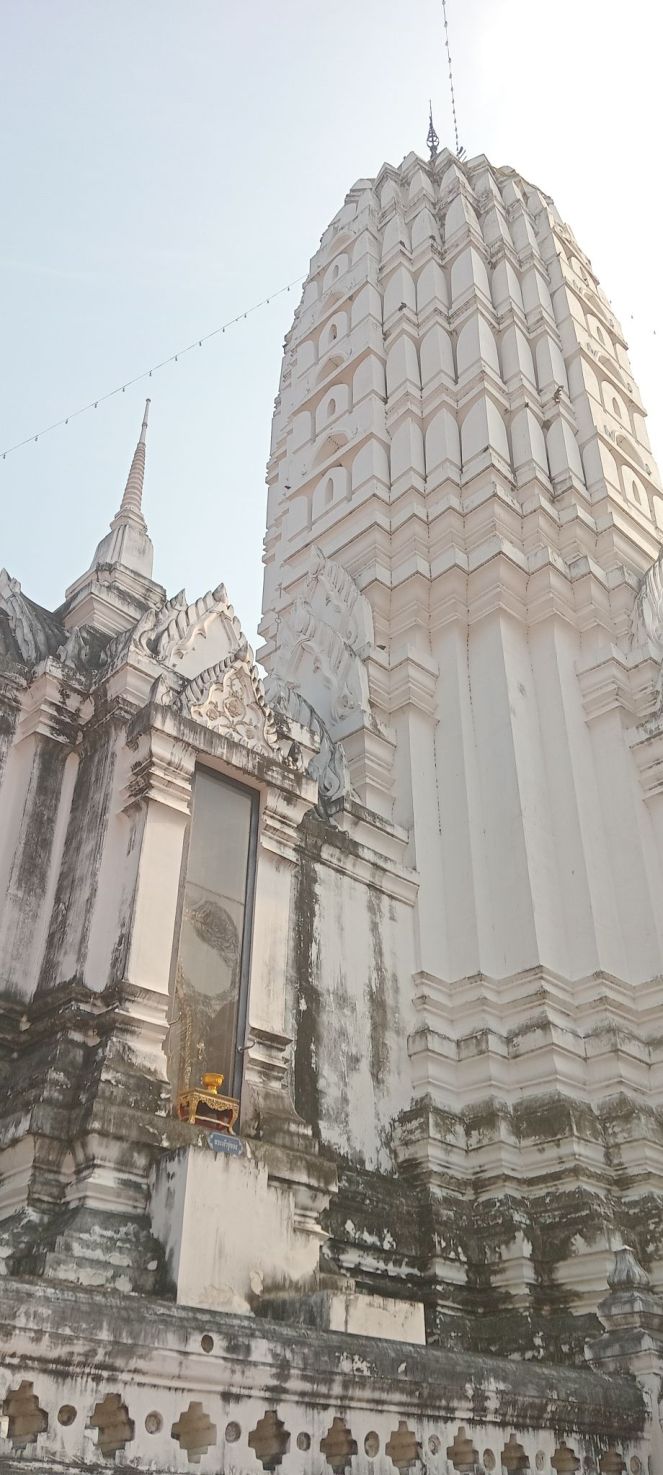
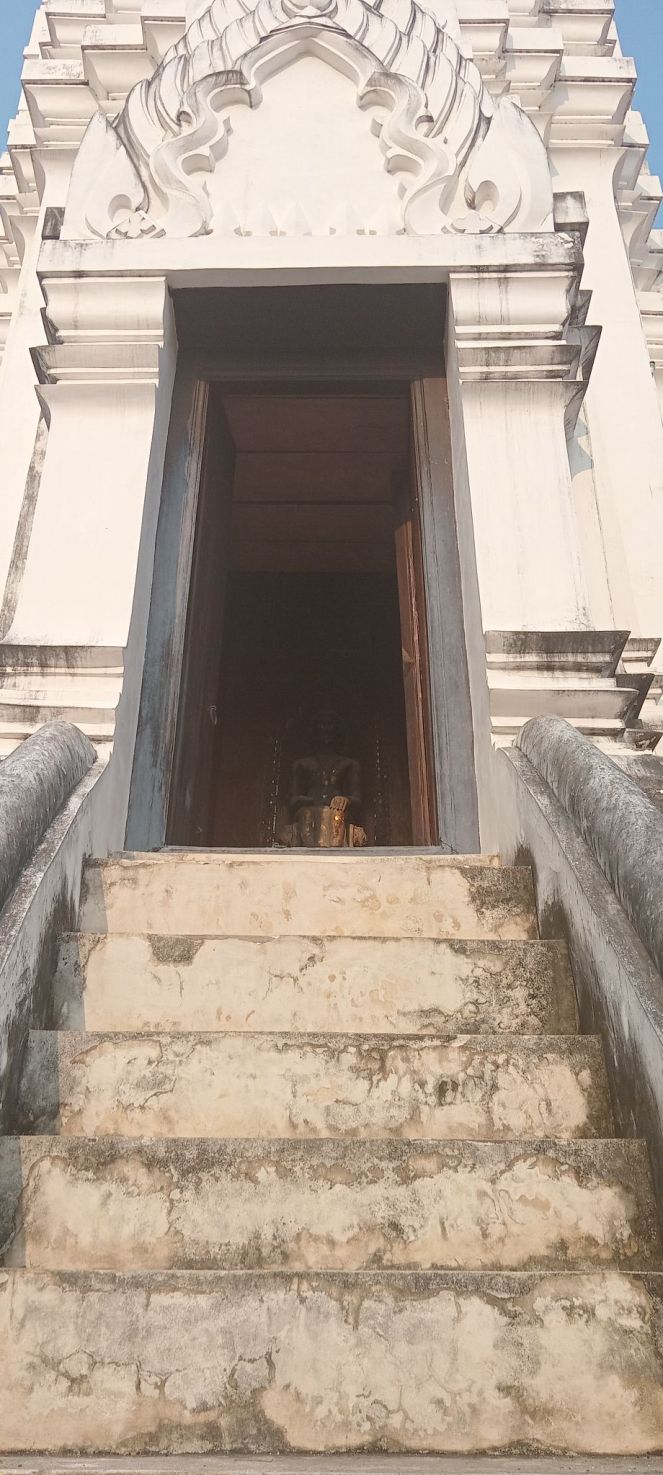
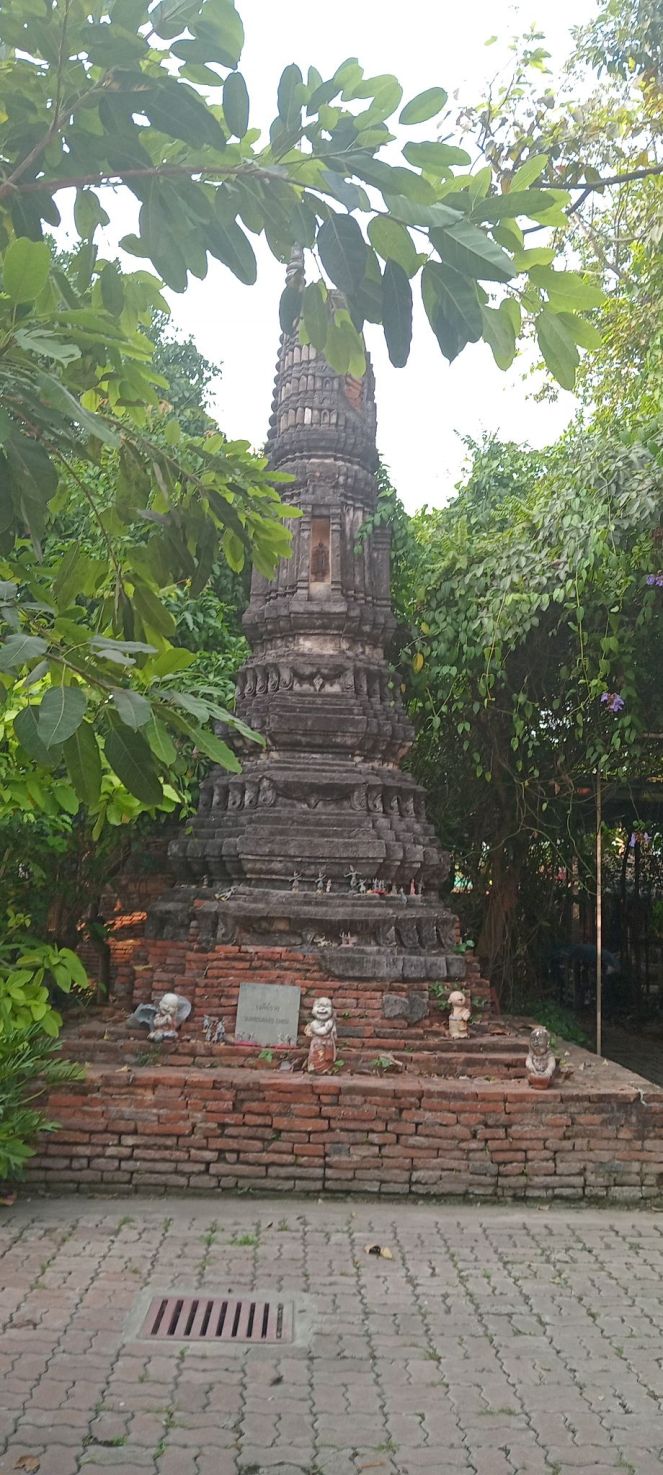
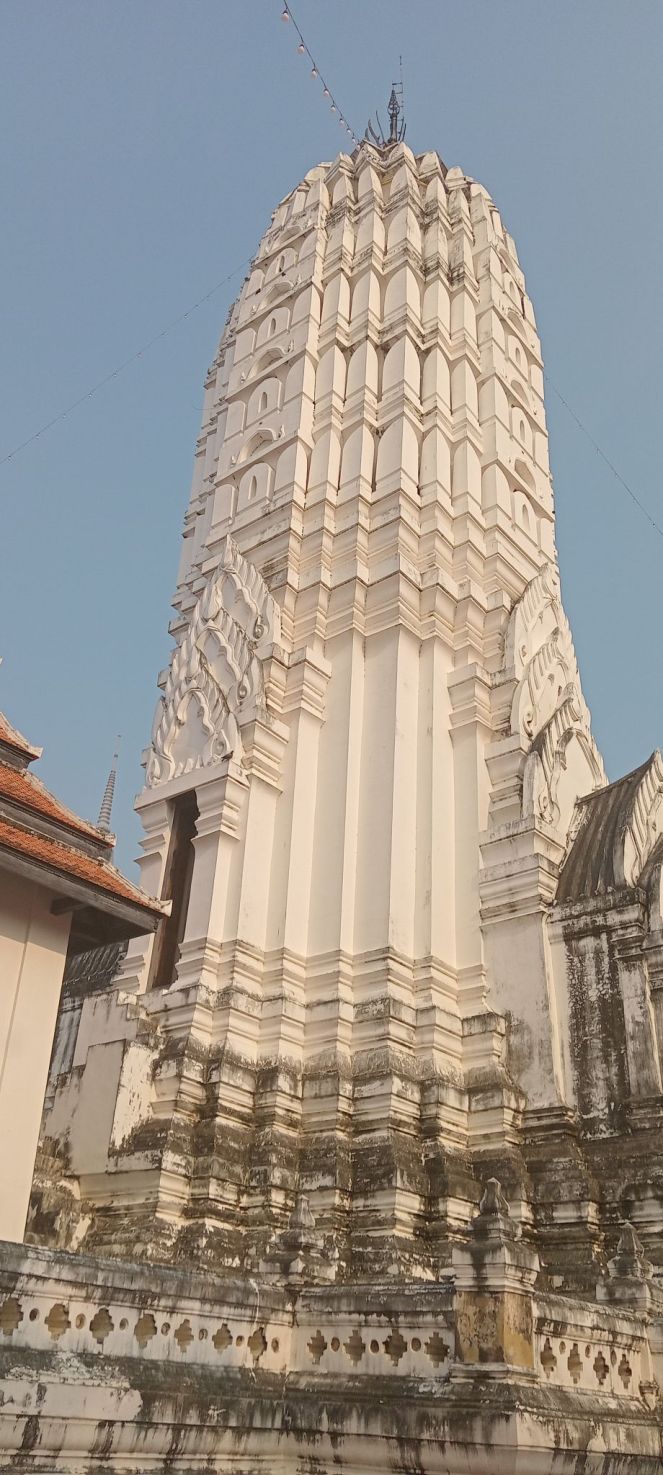

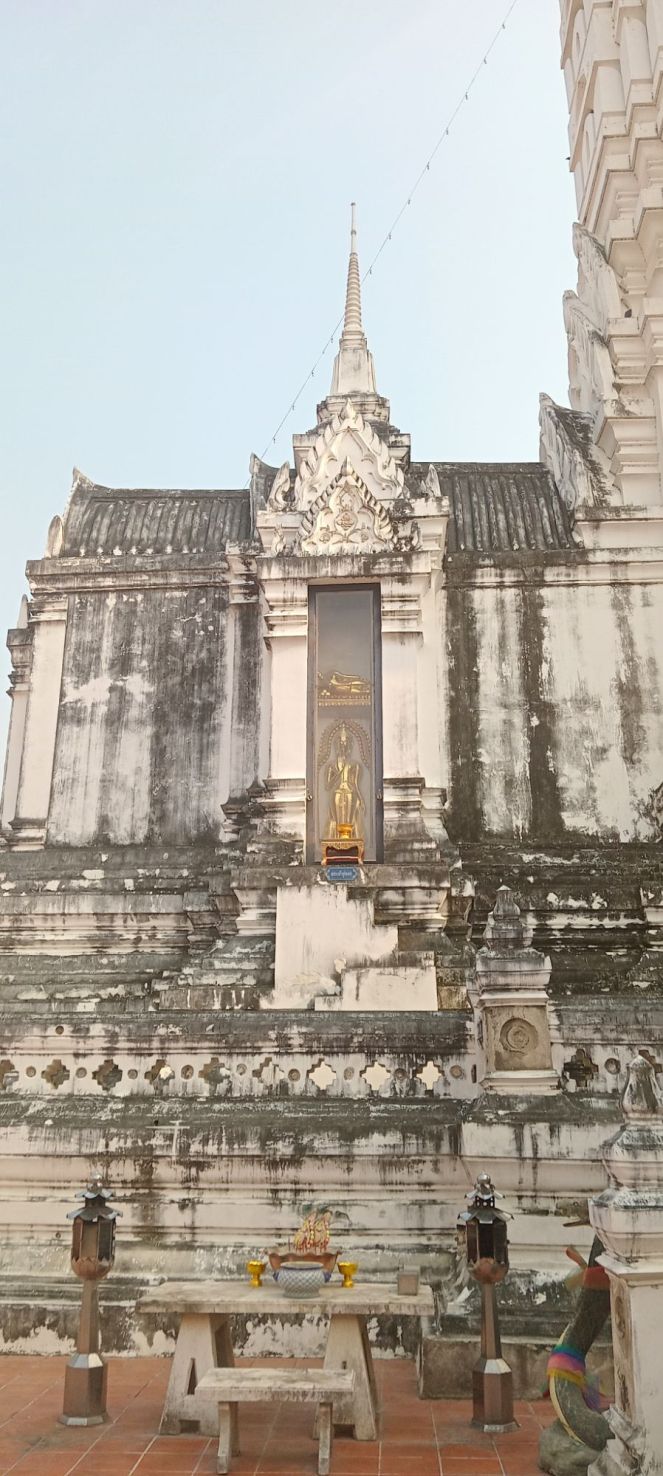
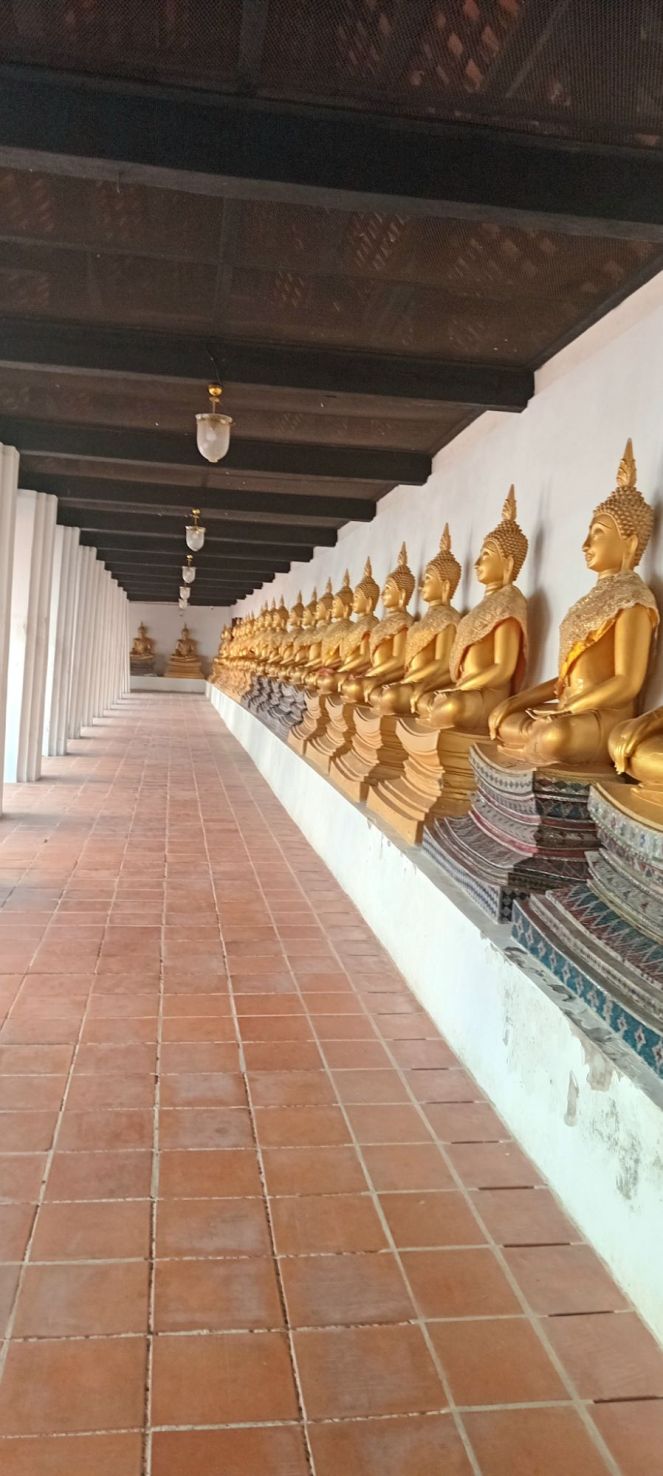
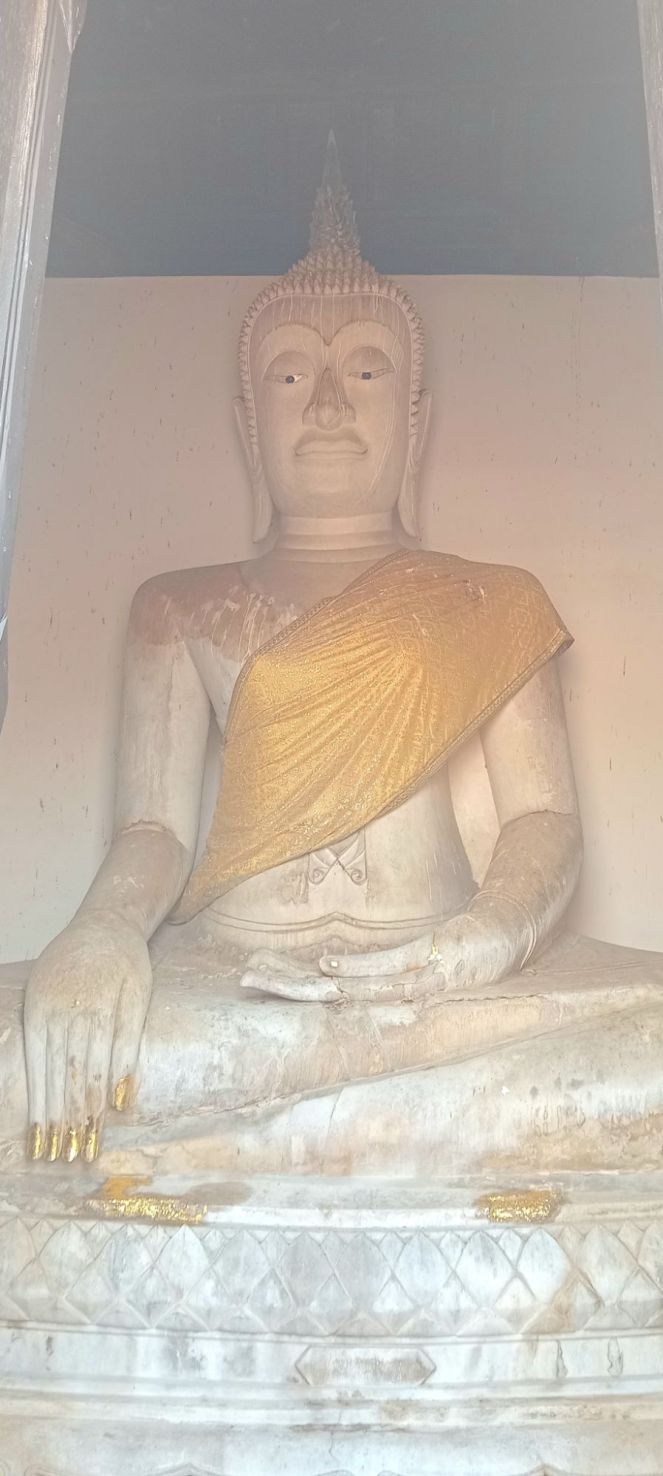
The ‘Angkor Wat’ and cosmological Mount Meru mandala of Ayutthaya: Wat Chai Attaranaram
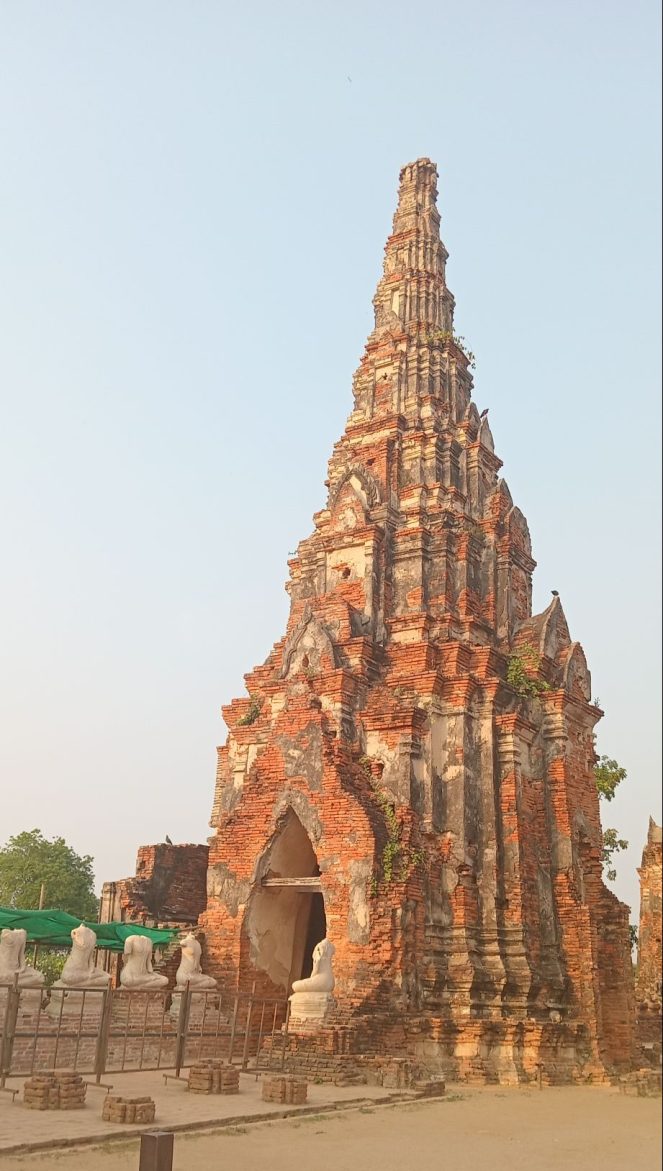

One of the other highlights of the trip, along with the Buddha head, is called the ‘Angkor Wat’ of Wat Chai Watthanaram or the Monastery of the Temple for the Advancement of Victory as Richard Cushman translated. I arrived as the sun was still setting, the final stop of the boat trip. is a restored ruin situated off the city island located on the west bank of the present Chao Phraya River in front of the Siriyalai Palace, which is situated directly across the river. The primary access to Wat Chai Watthanaram was from the river, as the waterways were the most important means of transport in that era.
The late Ayutthaya period begins in 1629 with the reign of King Prasat Thong and is most notable for the square-shaped or indented corners pagodas and for the re- emerging of the prang as the principal monument of the monastery. Khmer culture was revived with the building of Wat Chai Watthanaram. . King Prasat Thong (r.1629-1656) built this royal monastery on the bank of the Chao Phraya River in 1630 in order to make merit for his foster-mother, as well to show himself as a man of great Buddhist merit; in fact a political goal. The temple was built on the site where his foster-mother, the wife of Okya Sri Thammathirat, resided in Ayutthaya. Wat Chai Watthanaram was one of the grandest and most monumental ruins of Ayutthaya. The construction of the monastery may have taken 20 years to complete.
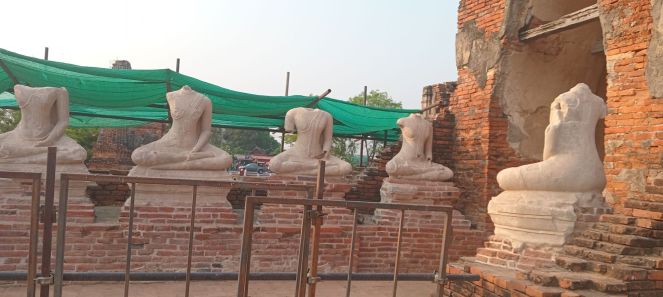
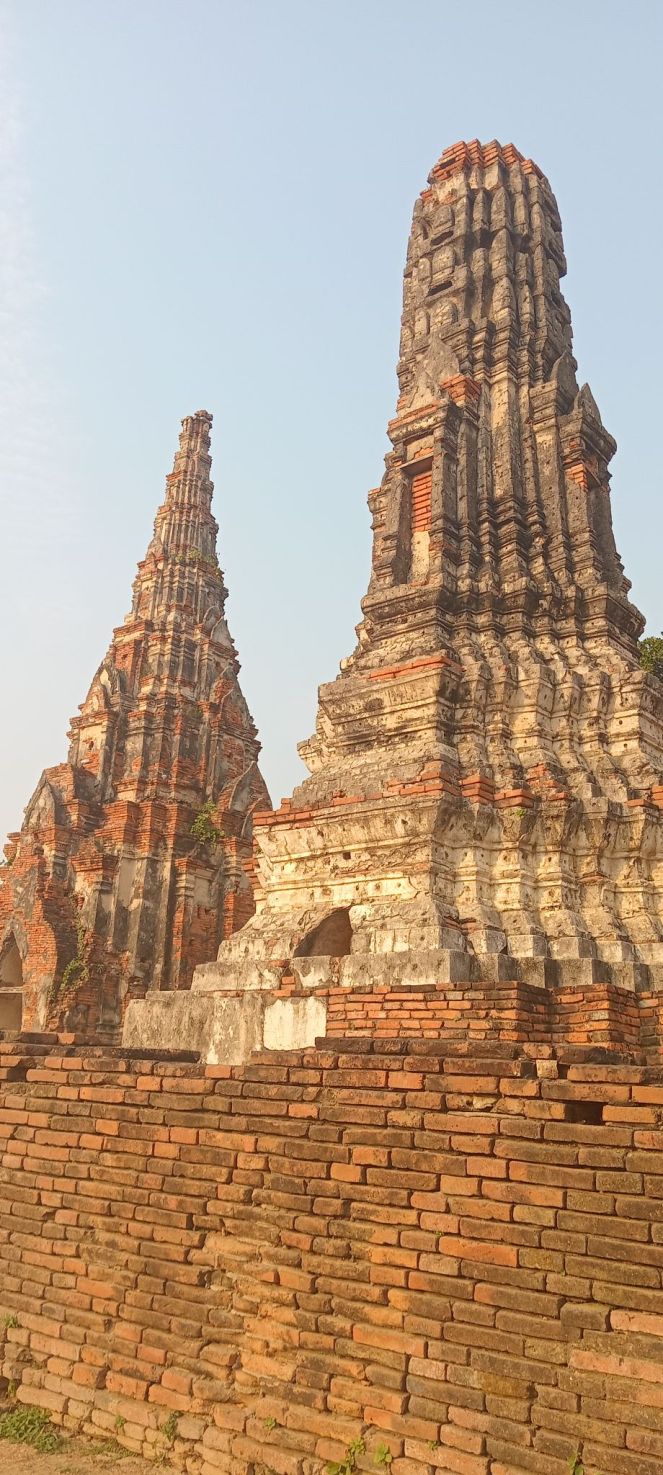

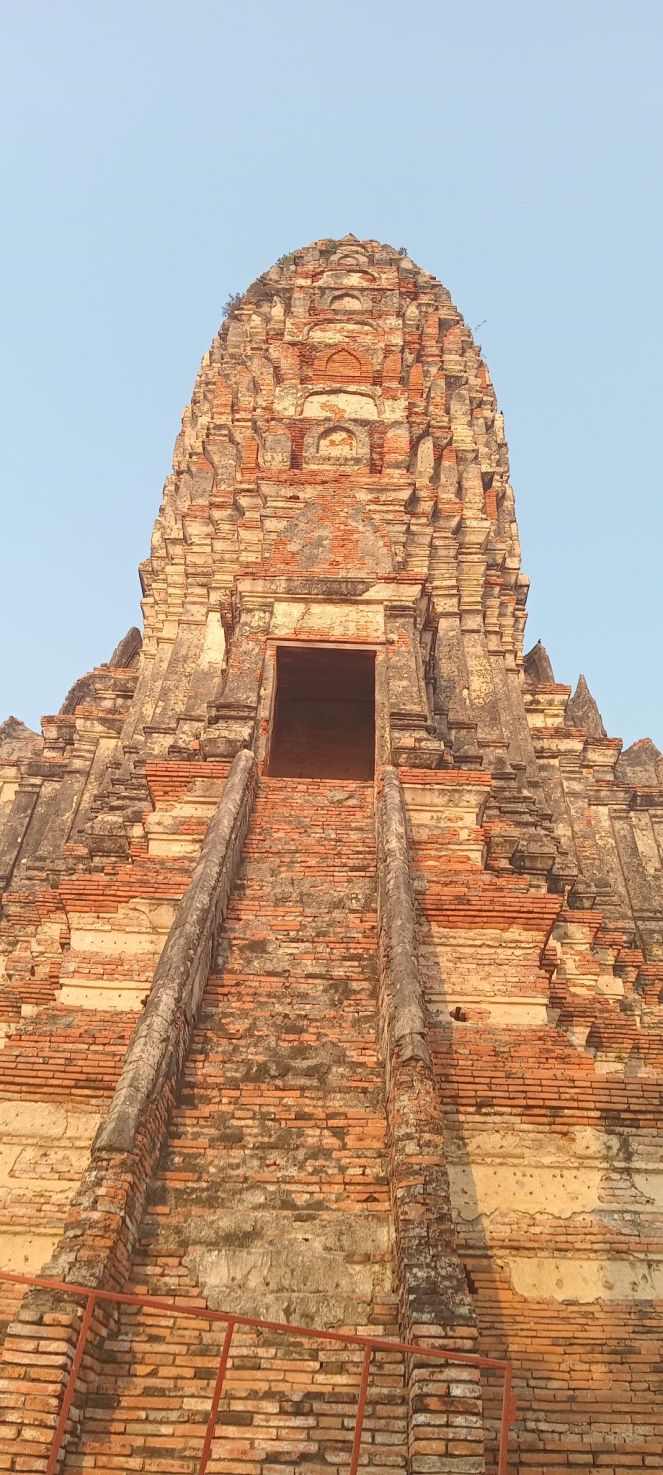
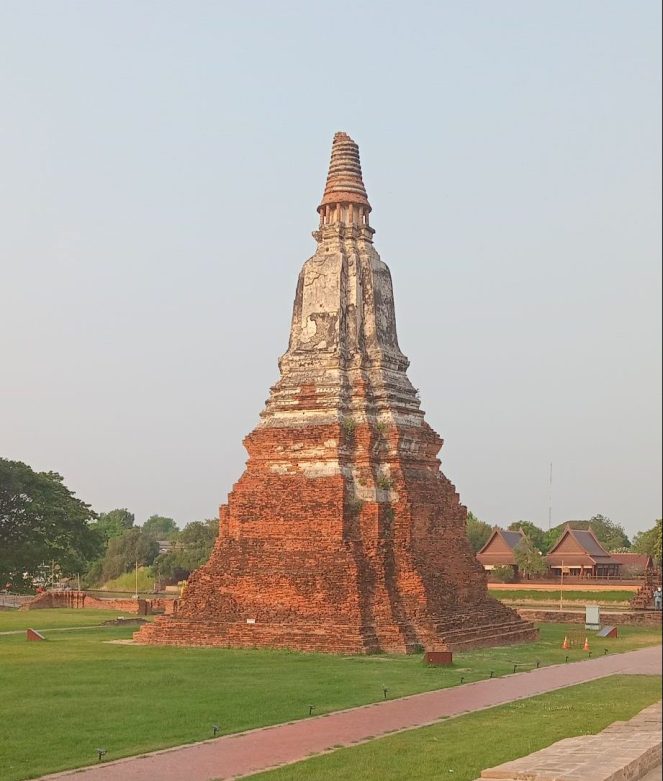

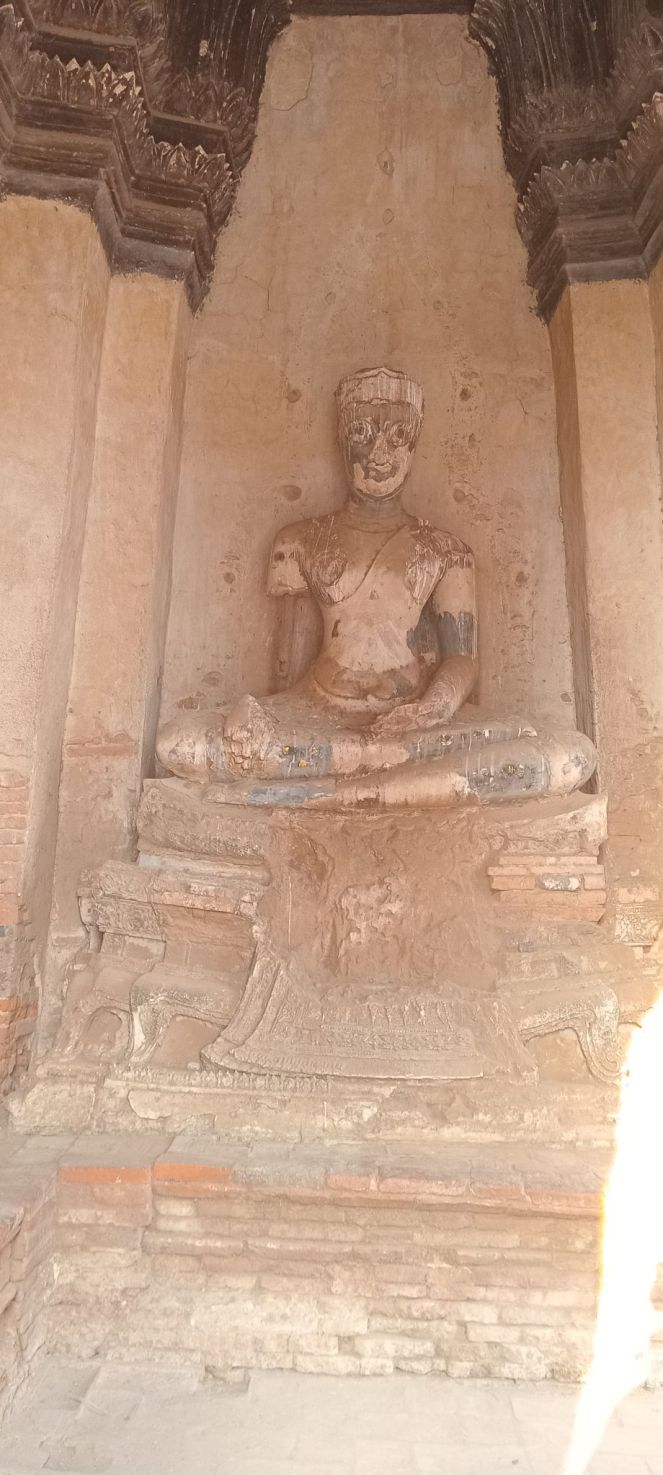
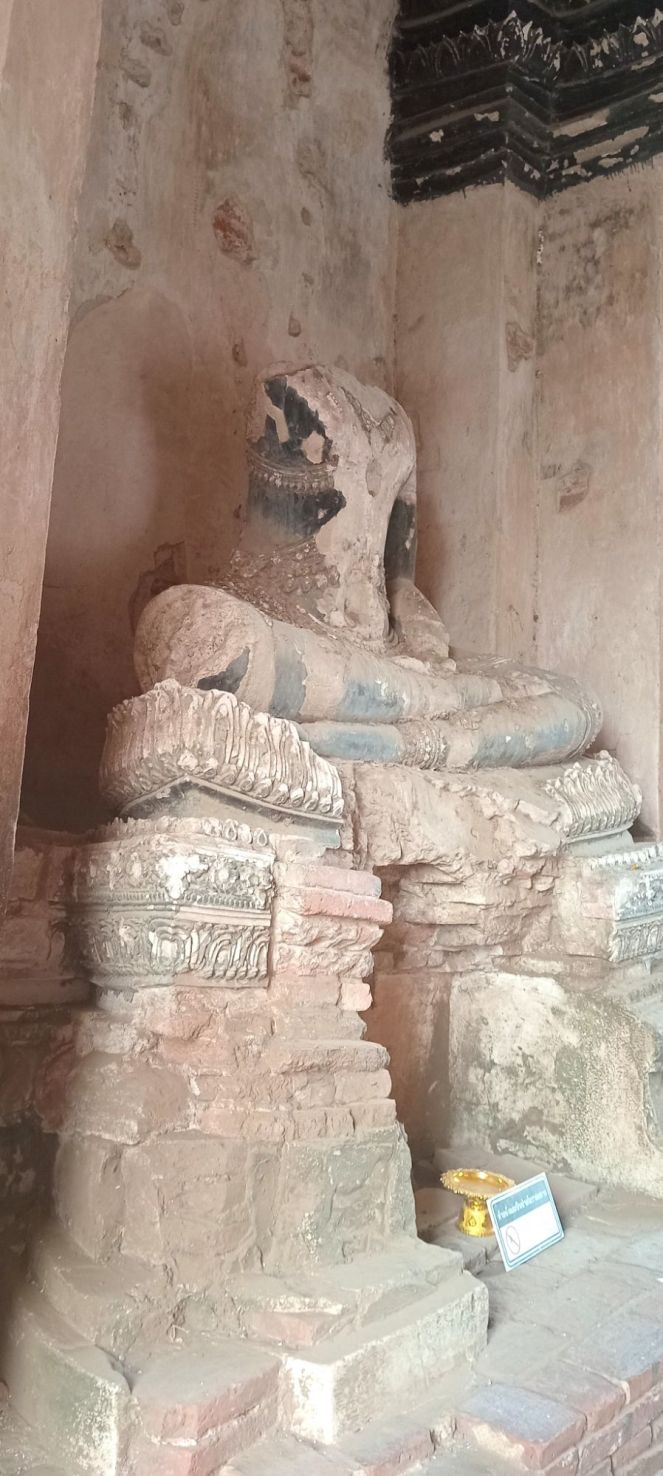
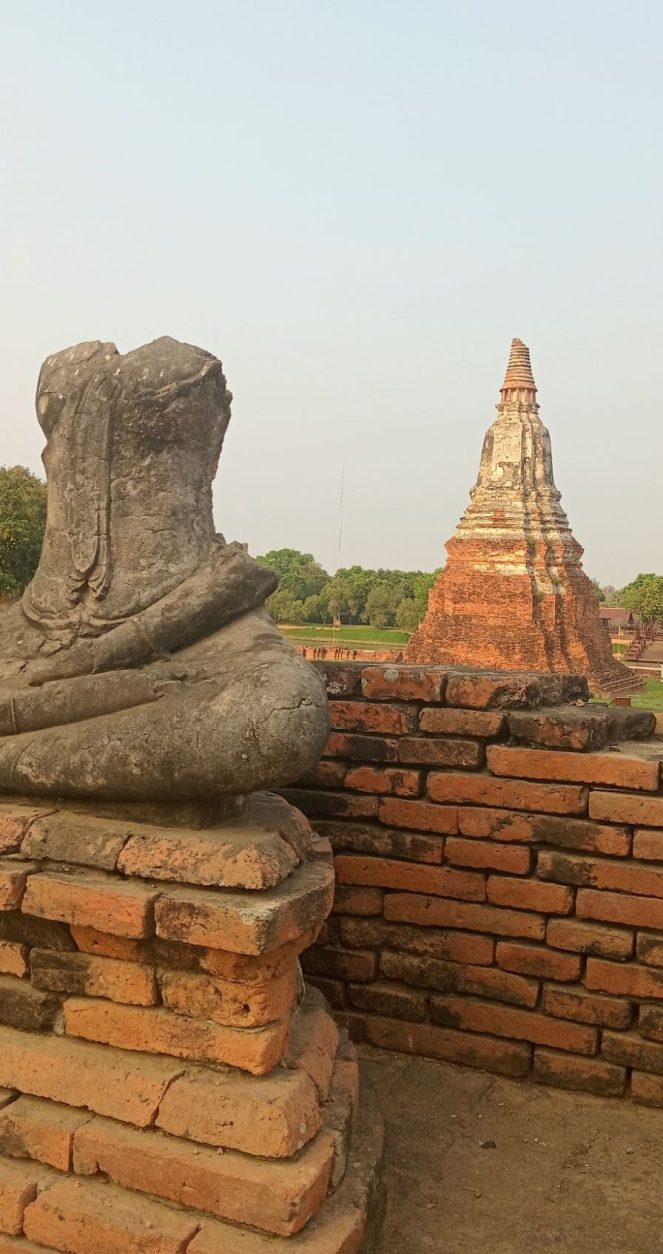
Movement of the sun and sunset at the Mount Meru cosmological mandala

Interestingly, for me as a Kālacakra scholar-translator who has studied the Mount Meru Kālacakra mandala in some detail from the practice perspective, it is said that Wat Chai Watthanaram reflects the Buddhist world view, as it’s described already in the Traiphum cosmography. As the sunset on the biuldings, the colour and energy changed into a fiery red-brick browns and golds, one could see the sun moving in the sky eventually reaching a central spire. Perfect setting for those interested in the movement of the planets and sun [2] Here are some photos I took trying to capture that phenomenon and experience:
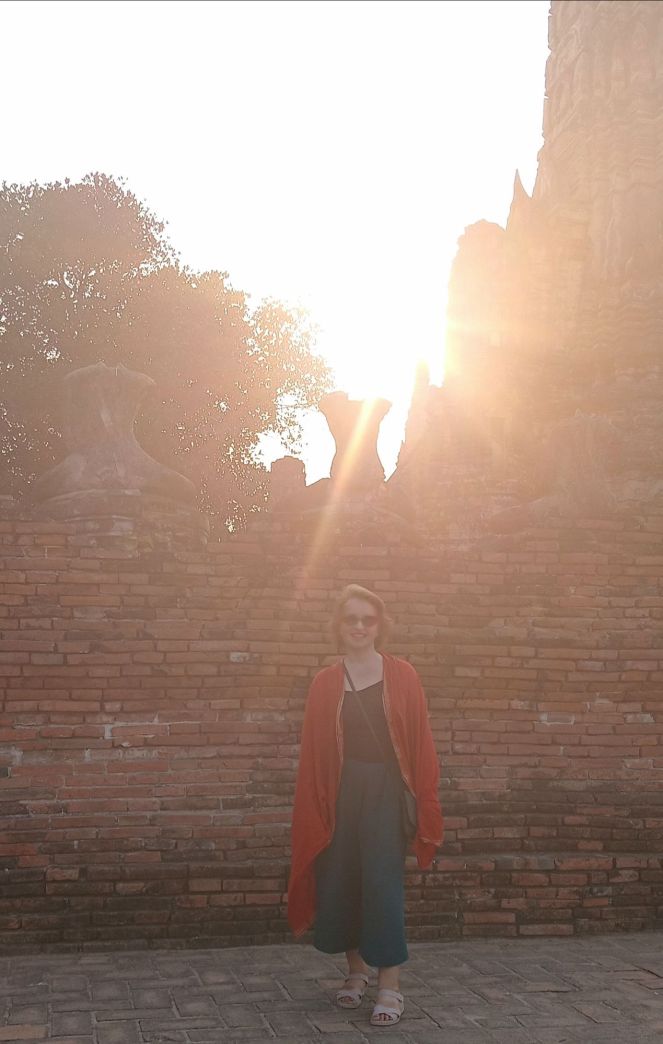
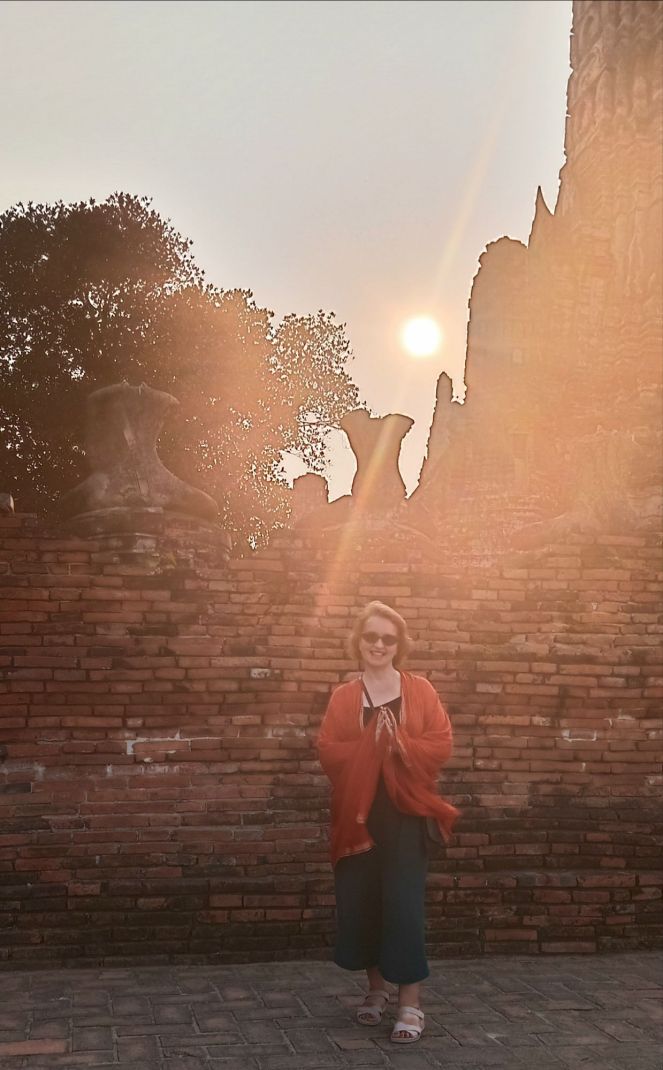
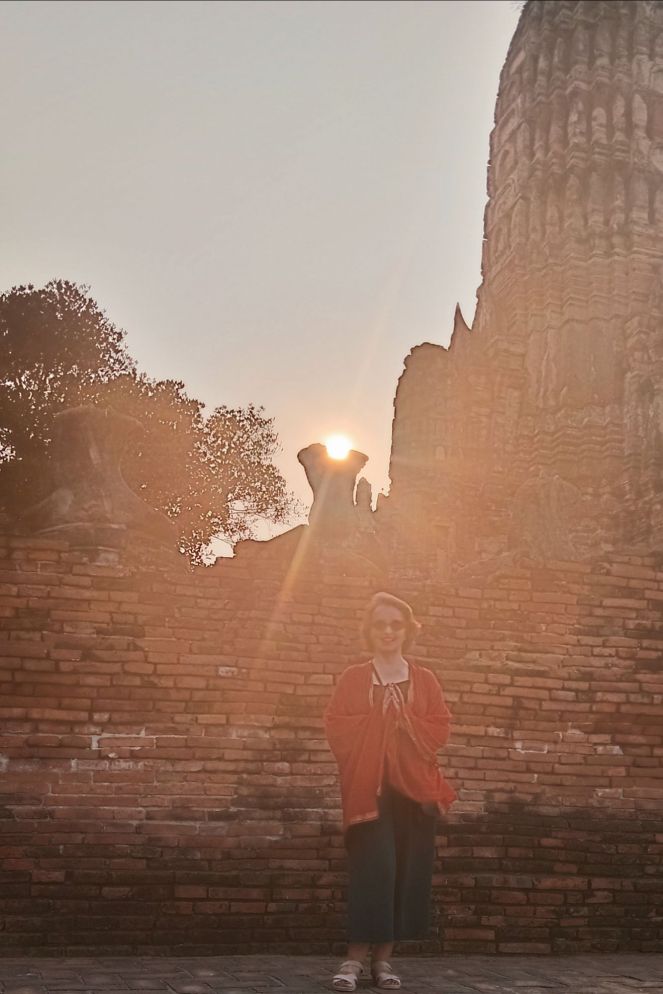


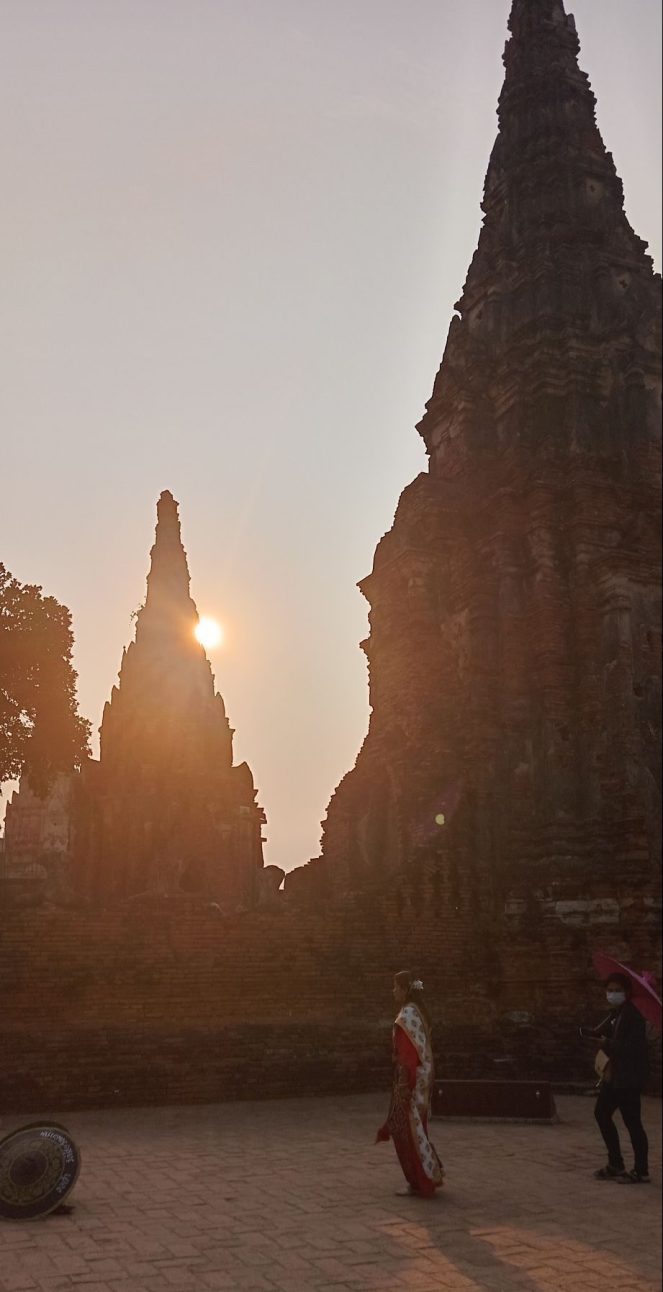
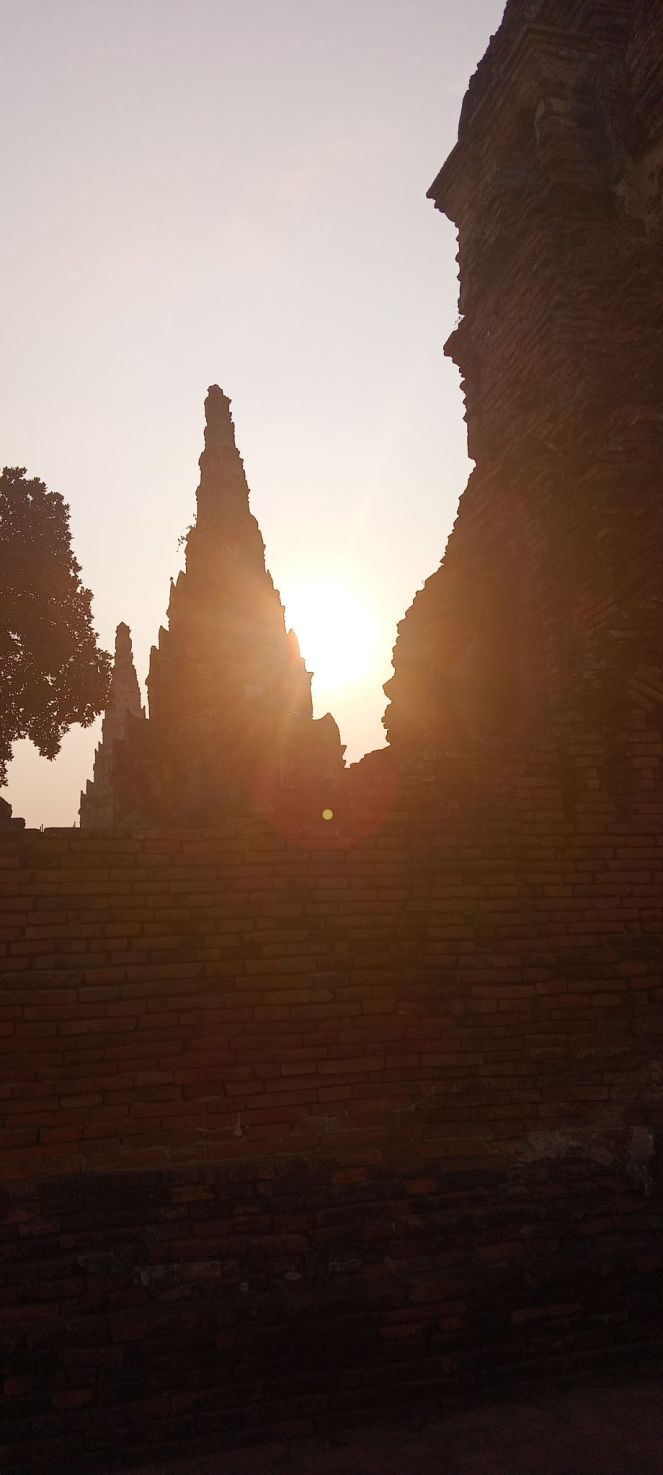
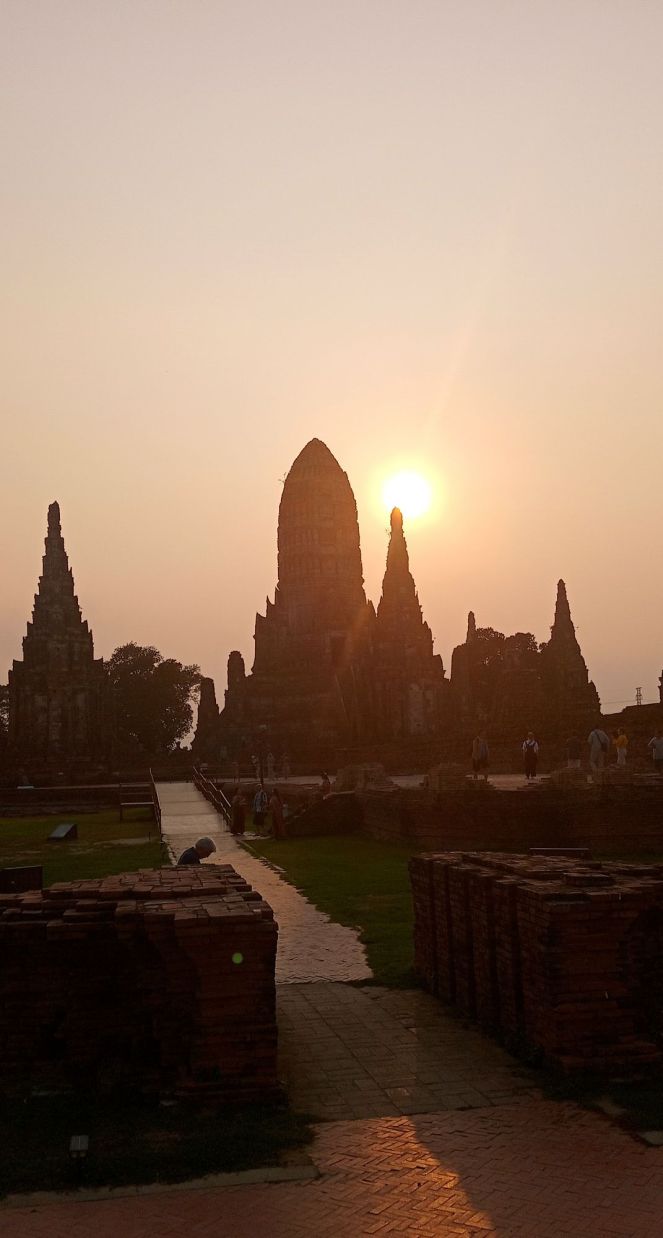
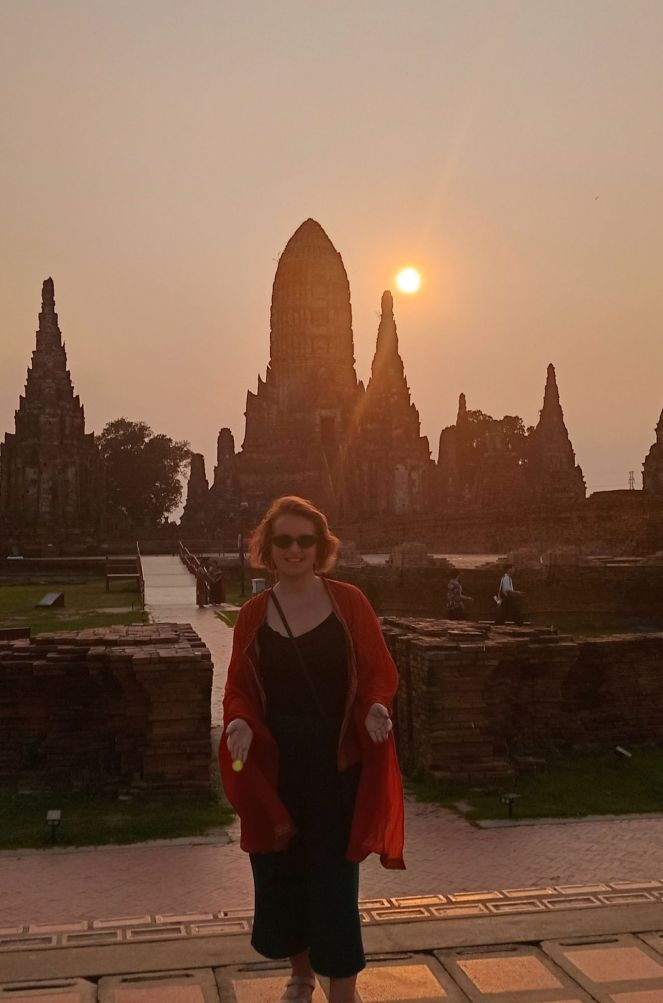
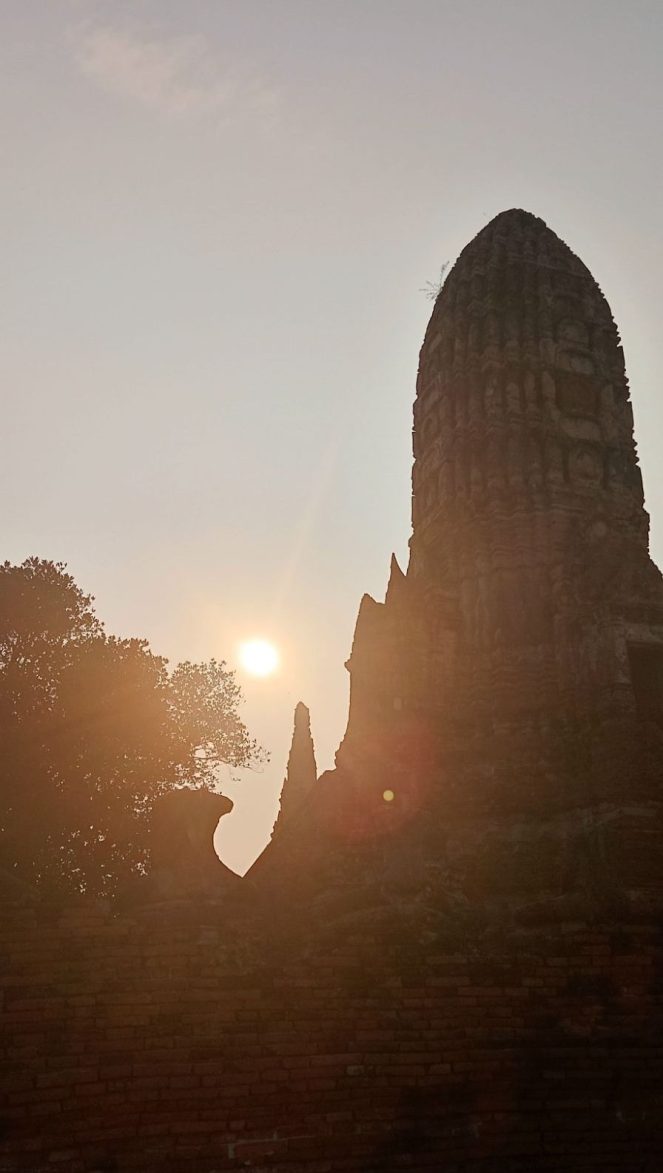
Primary excavations at this site were conducted after the excavations of Wat Phra Ram in 1958. Though the ancient structures had already been disturbed by the treasure hunters, many precious objects were unearthed in the crypt of the main prang. Only in 1987 did the Thai Department of Fine Arts start restoring the site. In 1992 it was opened to the public. The Thai government allocated 49 million Baht in April 2007 to save the historical river site from further erosion. The money was spent on reinforcing and strengthening the 20- year-old concrete dyke to prevent the Chao Phraya River from eroding the sanctuary.
Since the reign of King Prasat Thong all Ayutthayan Kings would regularly make pilgrimages to this sanctuary and attend royal funerals. In the last Burmese war with Ayutthaya (1764-1767), the site may have been used as a stronghold as witnessed by the reinforcement of the walls and the surviving remains of cannons and cannon balls. After the destruction of Ayutthaya by the Burmese, the temple was deserted, prey for the jungle and looters for 220 years.
Buddha’s Head in the old Bodhi tree roots – Wat Mahathat, Ayutthaya
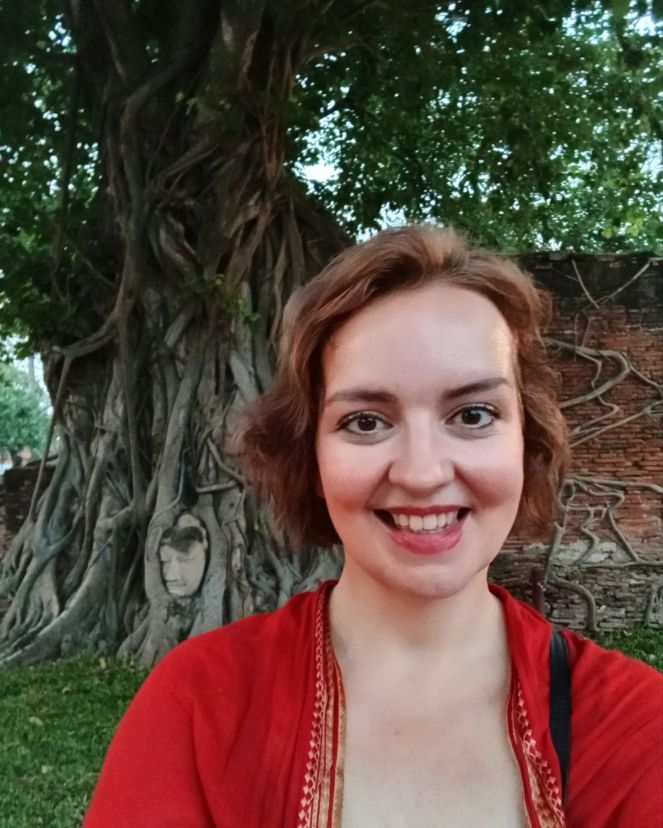
As I mentioned in the introduction, seeing the famous ‘Buddha head in the old Bodhi tree’ was the highlight (or lowlight, as I arrived as the sun was still setting) and very moving indeed. As a teenager onwards, I used to have a photo of this iconic image on my wall and was always struck by its mystery and beauty, even before I ‘became a Buddhist’. However, as we all know, the photo is no substitute for being there in person. It is located at Wat Mahathat in Ayutthaya, which I visited by rickshaw after the boat trip.
The ancient temple in the location is believed to have been built around 14th century but was destroyed and reduced to ruins in 1767 during the invasion of Ayutthaya by the Burmese army. The invaders also vandalized many of the Buddha images and Buddha heads in Ayutthaya. The site remained abandoned until the early 1950s when the Department of Fine Art of Thailand began the restoration work in Ayutthaya. There is still no exact history of how the Buddha head became entwined in the roots of the tree. Among many theories, one theory suggests that the tree grew around the head of the Buddha when the temple was left abandoned. Similarly, another theory also states that a thief moved the Buddha head away from the main temple in Ayutthaya to hide it. But after moving the stone Buddha head away from the ruined main temple, it is believed that the thief could not move the head beyond the walls surrounding the temple. Instead of that, the stone Buddha head was left by the wall where it got nestled in the tree roots which have grown and entwined around it.
The energy and sheer scale and beauty of the place, the exhaustions of solo travel and the hot weather led to me being in a fragile emotional (yet open state) when I arrived at the tree during sunset, literally brought me to my knees and I knelt before it tears poured from eyes, in awe, love and gratitude to witness its sublime beauty. It was like the head itself was vibrantly alive, as if the energy of prayers and pilgrims had enlivened it over the years. I also felt I had visited the place and even seen the statue before. I stopped there for some time to make aspirations and prayers in front of it and I was almost the only person there. No one else was around there anymore, as it turned dark. The stone head could still be seen in the dark lit up by the golden lights within the temple complex. I could have spent hours there meditating on it and absorbing the energy of the place.
There were no security guards around the Buddha head tree. which also surprised me, considering the intense security presence at Buddhist temples in Kandy and in Bangkok. It reminded me of the ancient Nalanda ruins in India and how people had wantonly and disrespectfully graffited names and other things on the ancient monastic cell rooms and walls. Here, there was no graffiti and no vandalism though. In fact, there were not many people there at all. I took some photos to as memories to share with others and left changed by it with a deep, imprinted memory of it.




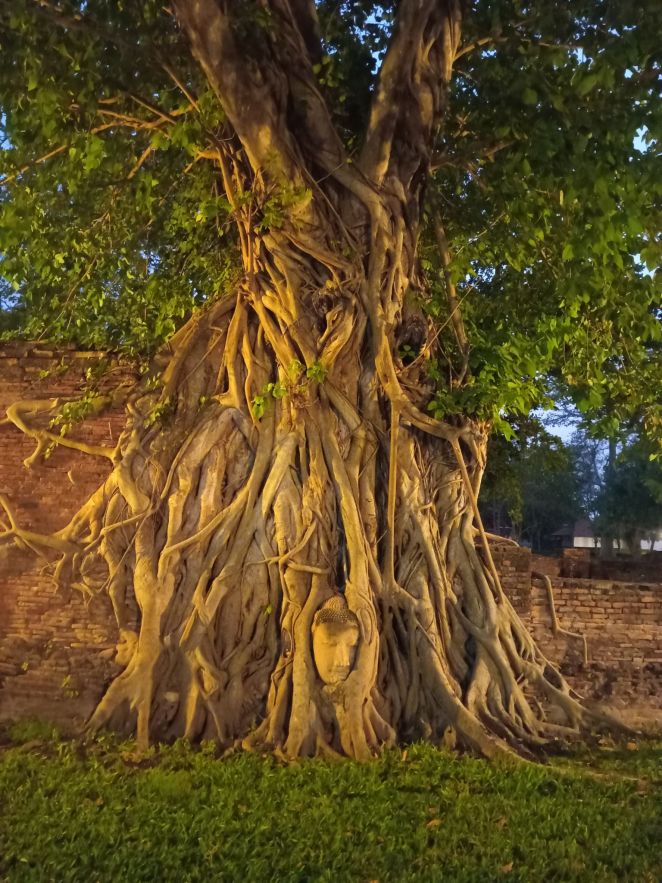

Other buildings and statues next to the Wat Mahathat complex:

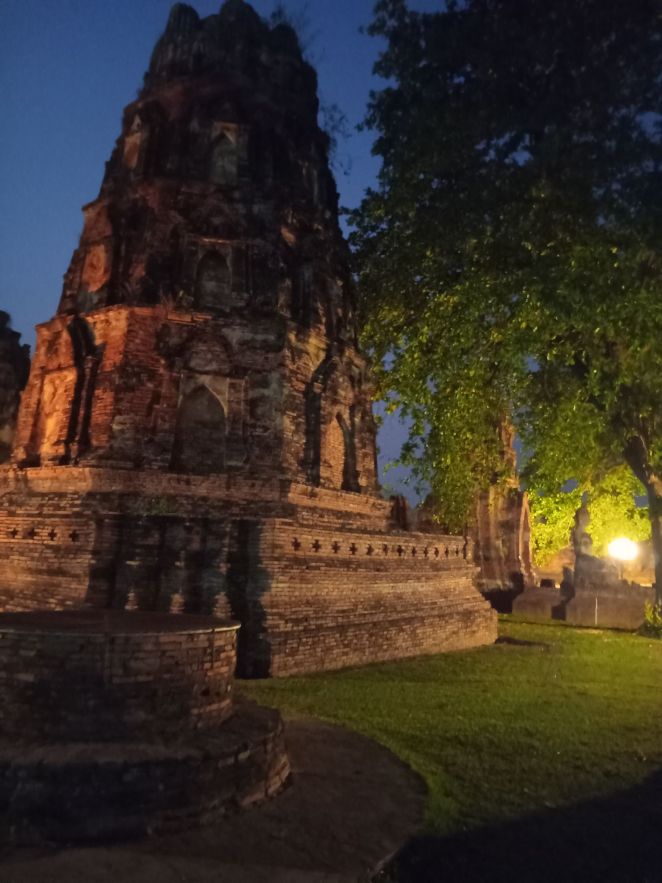
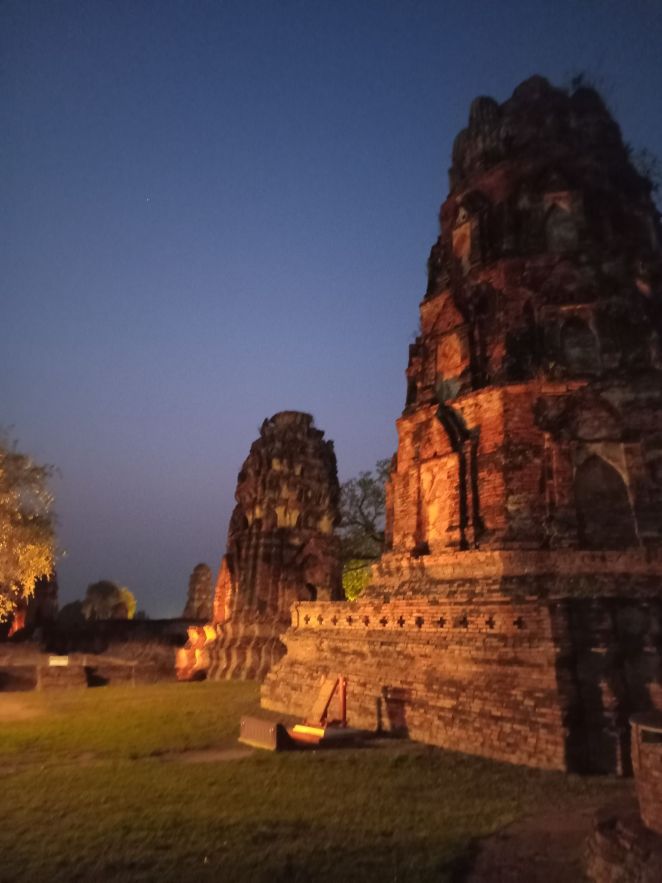
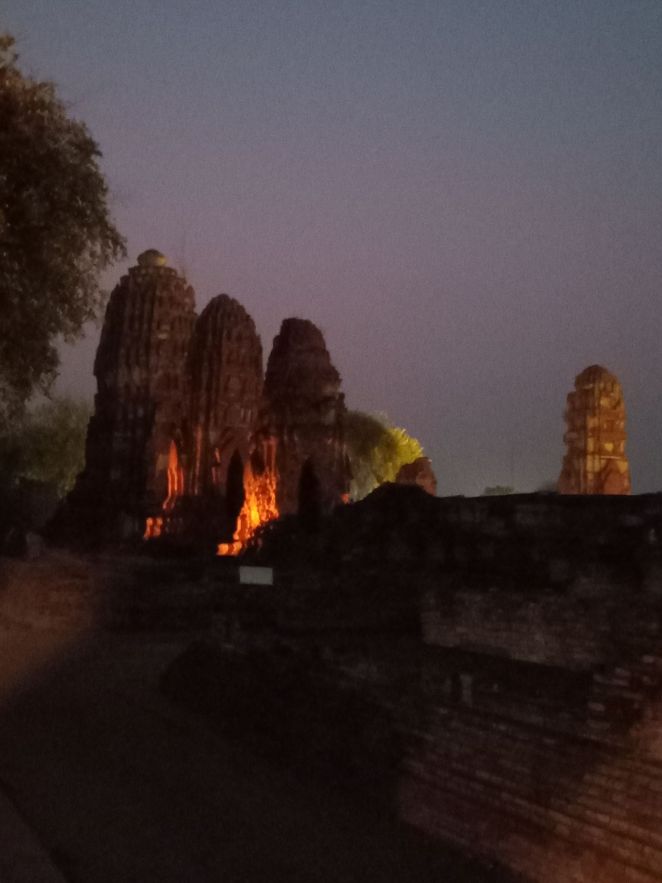


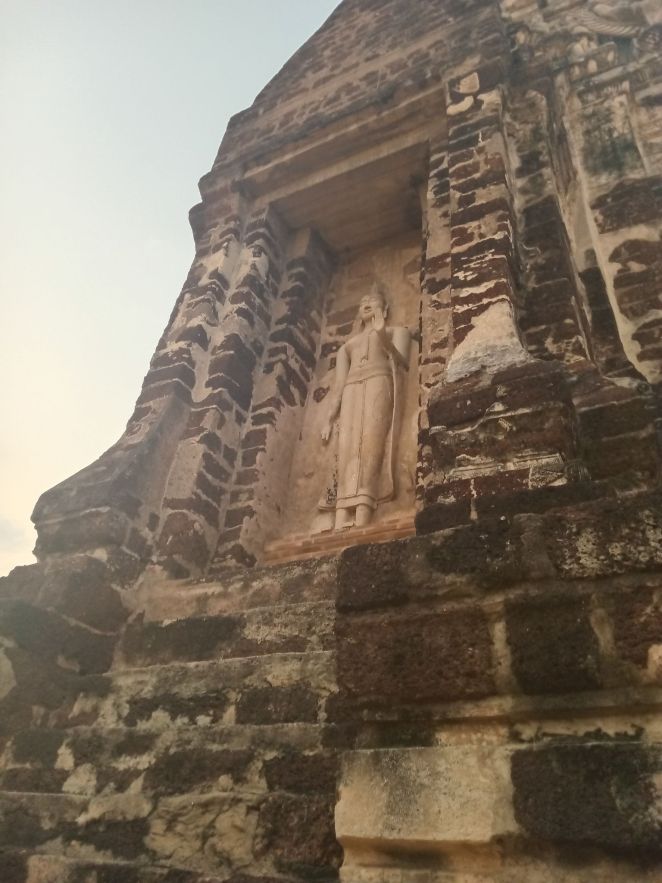
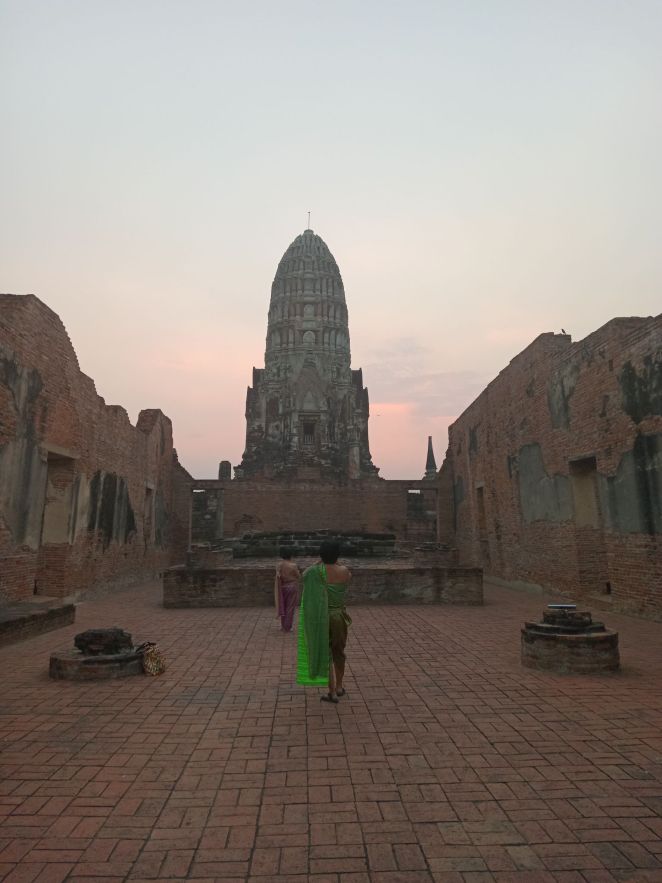
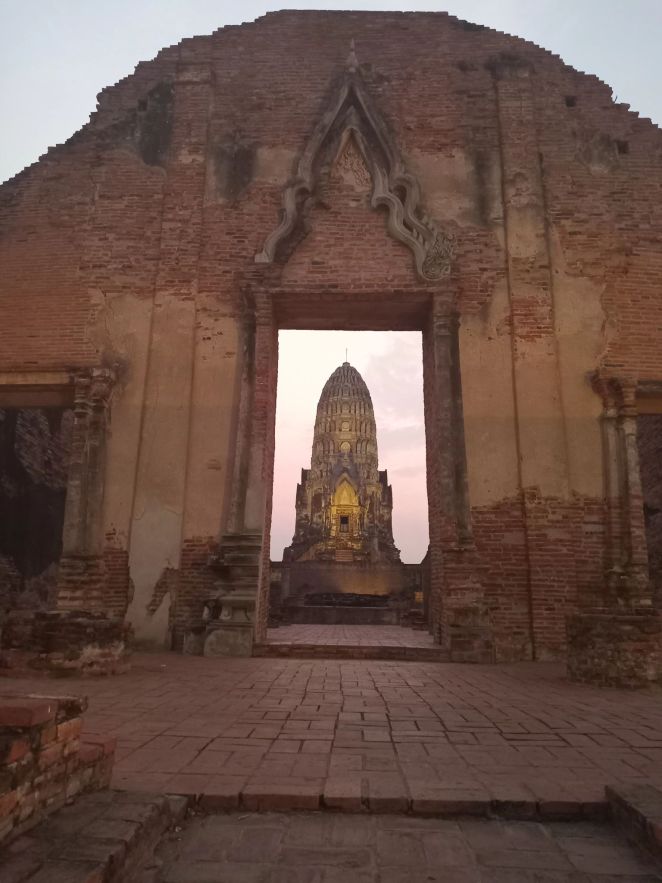
Endnotes
[1] According to the UNESCO World Heritage site: “The Historic City of Ayutthaya, founded in 1350, was the second capital of the Siamese Kingdom. It flourished from the 14th to the 18th centuries, during which time it grew to be one of the world’s largest and most cosmopolitan urban areas and a center of global diplomacy and commerce. Ayutthaya was strategically located on an island surrounded by three rivers connecting the city to the sea. This site was chosen because it was located above the tidal bore of the Gulf of Siam as it existed at that time, thus preventing attack of the city by the sea-going warships of other nations. The location also helped to protect the city from seasonal flooding.
The city was attacked and razed by the Burmese army in 1767 who burned the city to the ground and forced the inhabitants to abandon the city. The city was never rebuilt in the same location and remains known today as an extensive archaeological site. At present, it is located in Phra Nakhon Si Ayutthaya District, Phra Nakhon Si Ayutthaya Province. The total area of the World Heritage property is 289 ha.
Once an important center of global diplomacy and commerce, Ayutthaya is now an archaeological ruin, characterized by the remains of tall prang (reliquary towers) and Buddhist monasteries of monumental proportions, which give an idea of the city’s past size and the splendor of its architecture.
Well-known from contemporary sources and maps, Ayutthaya was laid out according to a systematic and rigid city planning grid, consisting of roads, canals, and moats around all the principal structures. The scheme took maximum advantage of the city’s position in the midst of three rivers and had a hydraulic system for water management which was technologically extremely advanced and unique in the world.”
[2] “The universe consists of an infinite number of solarsystems (Chakrawan), each depending on a central mountain named Phra Men, or Meru. Around this central mountain are eight circular belts of ocean, divided from each other by seven annular mountains (Satta Boriphan). Outside of all is an eighth ring of mountains, called the Crystal Walls of the World. On the ocean between the seventh mountain-chain and the walls of the world, which is called the Great Ocean, are four groups of islands, each consisting of a principal island and 500 satellites. The group to the south, called Jambudvipa (Siamese, Chomphu Thawip), is that inhabited by man; the groups to the north, the east, and the west, are inhabited by beings akin to man, but differing in appearance.
It is said that Wat Chai Watthanaram reflects the Buddhist world view, as it’s described already in the Traiphum cosmography. The universe consists of an infinite number of solarsystems (Chakrawan), each
depending on a central mountain named Phra Men, or Meru. Around this central mountain are eight circular belts of ocean, divided from each other by seven annular mountains (Satta Boriphan). Outside of all is an eighth ring of mountains, called the Crystal Walls of the World. On the ocean between the seventh mountain-chain and the walls of the world, which is called the Great Ocean, are four groups of islands, each consisting of a principal island and 500 satellites. The group to the south, called Jambudvipa (Siamese, Chomphu Thawip), is that inhabited by man; the groups to the north, the east, and the west, are inhabited by beings akin to man, but differing in appearance. [19]
The main prang represents as thus Mount Meru, the central axis of the world and the abode of the gods; the prang is surrounded by four smaller prangs at each corner on the same platform, representing the four continents; the courtyard represents the seven oceans and the gallery the seven annular mountains. The outer wall symbolizes the crystal mountain Chakrawan and as thus is called Kamphaeng Kaeo or crystal wall.” For more, see : https://www.ayutthaya-history.com/Temples_Ruins_ChaiWatthanaram.html

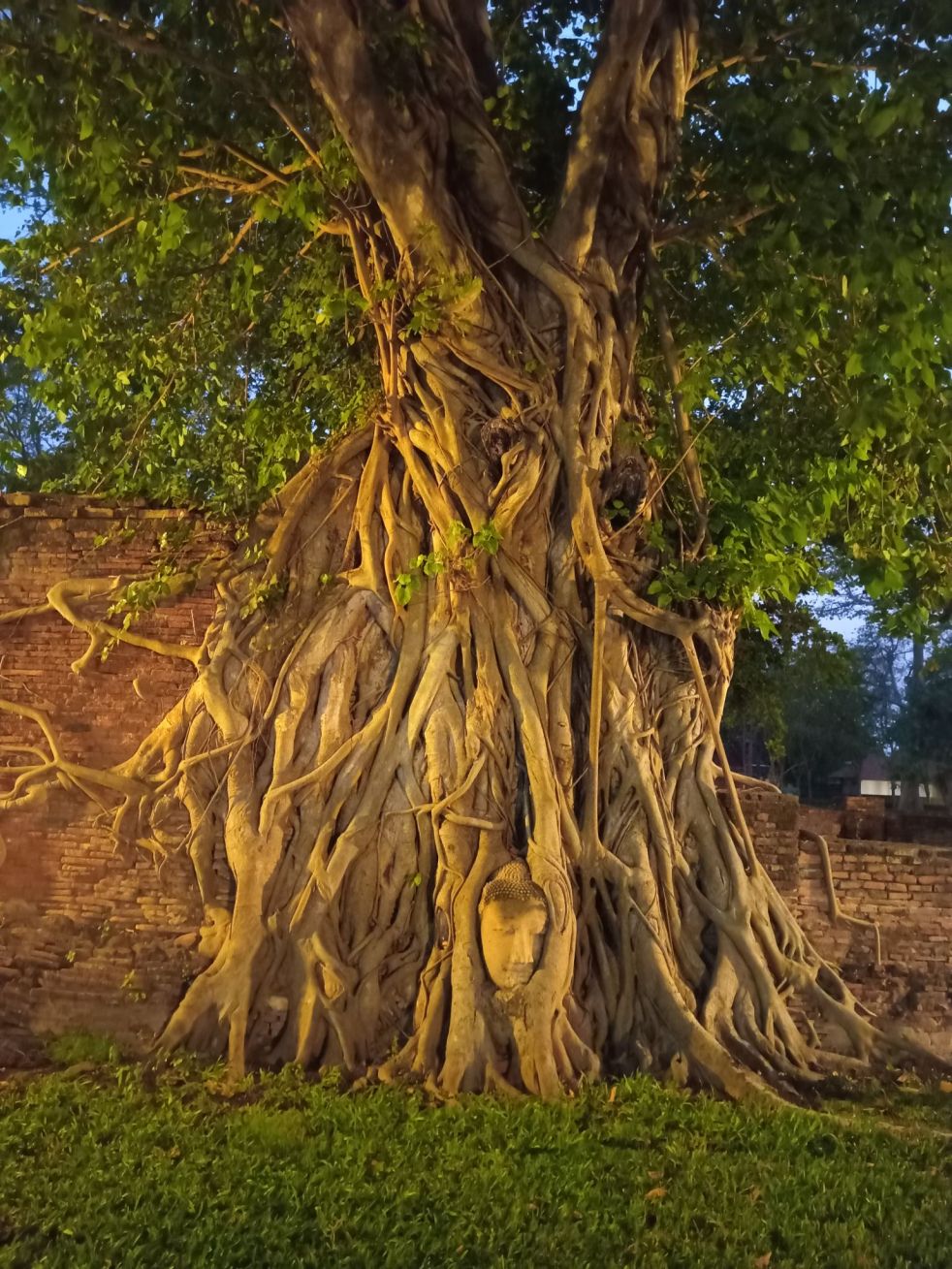

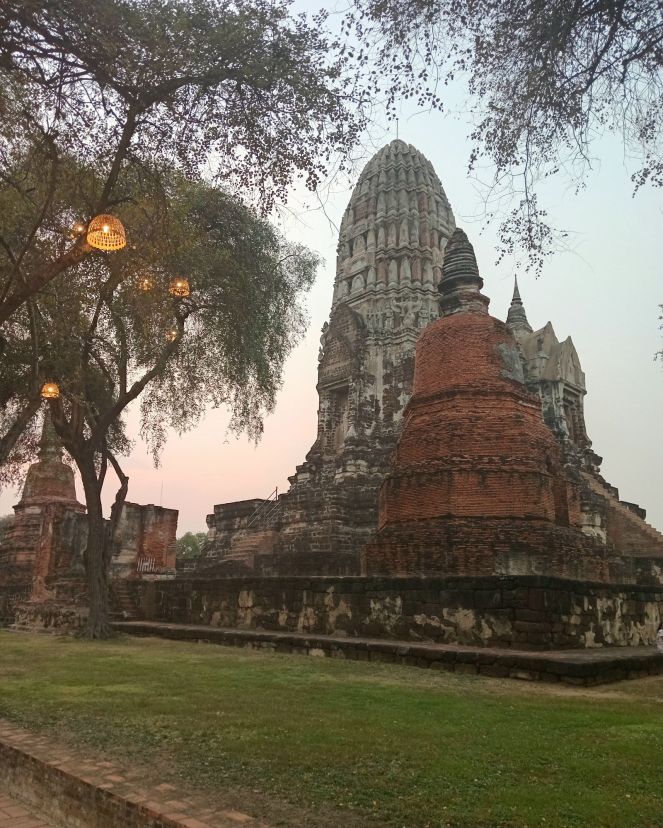

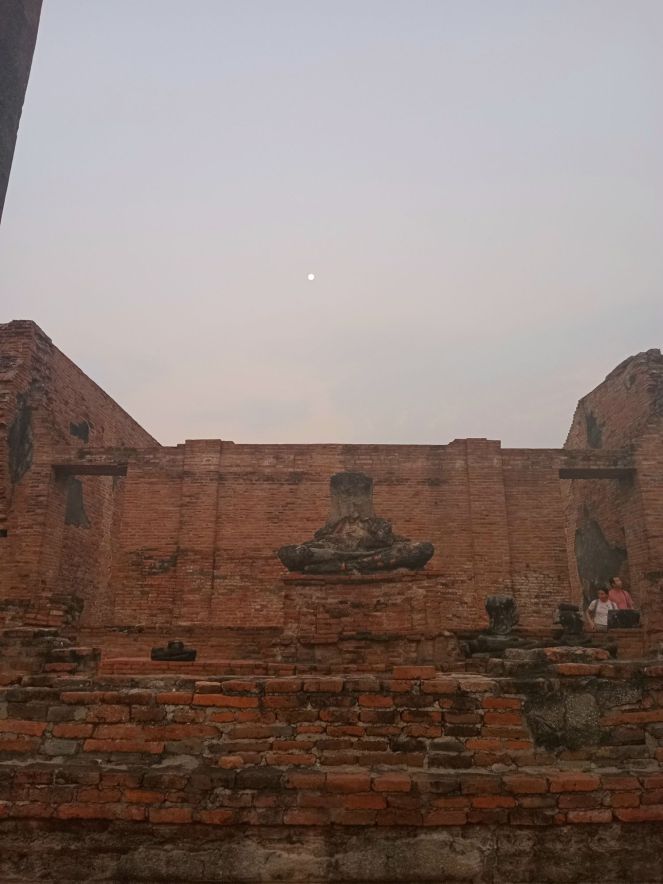
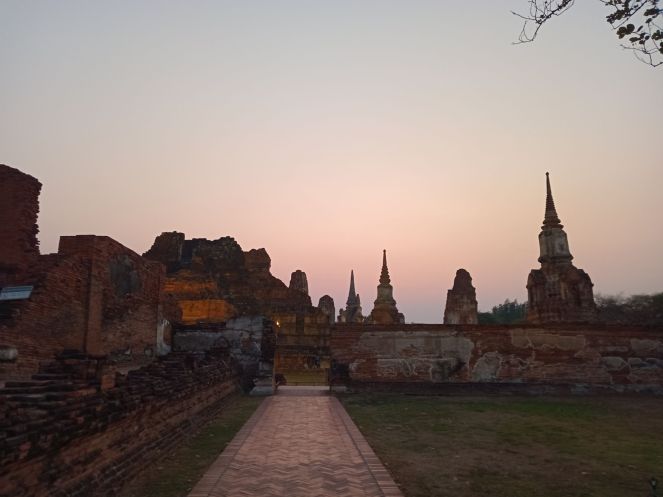

Thanks so much for sharing the beauty and blessings of all your teachings and travels… just listened to this…
stillness watches movement…
best wishes,
please continue…
Get Outlook for iOShttps://aka.ms/o0ukef
Thank you and welcome!
ah dele
happi to see all your dreams coming true.
sometimes it just” feels as if we’ve lost our head”
and then it all comes back , and we’re ok again
Tug Je chay